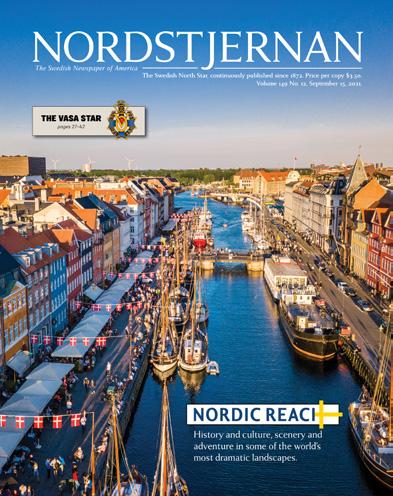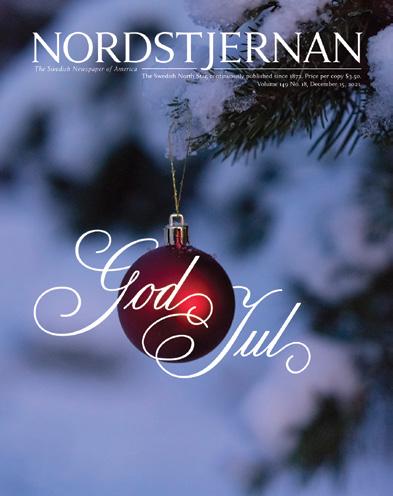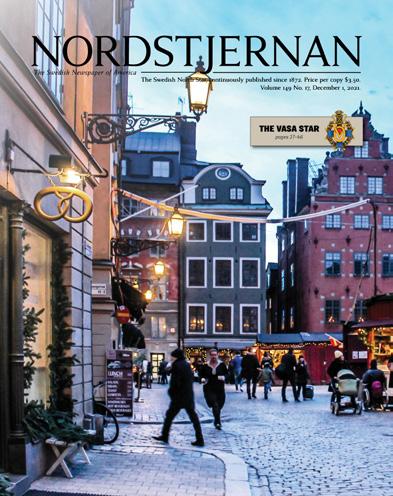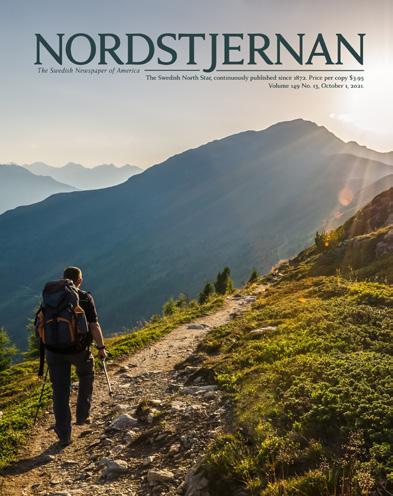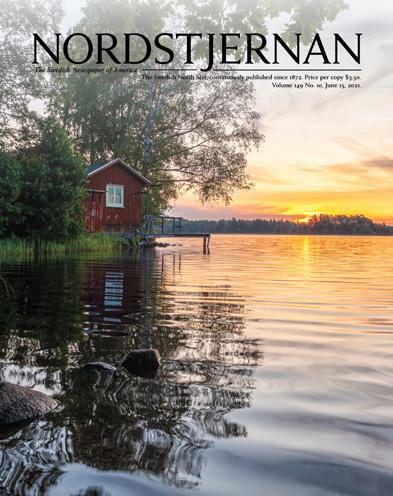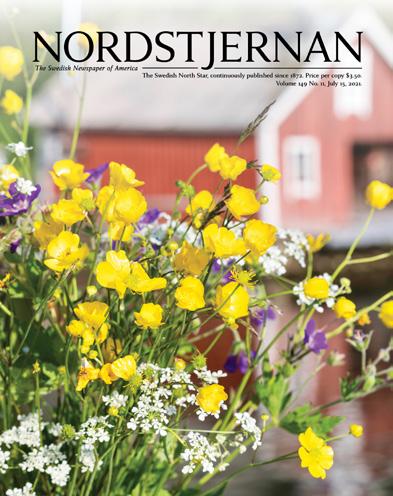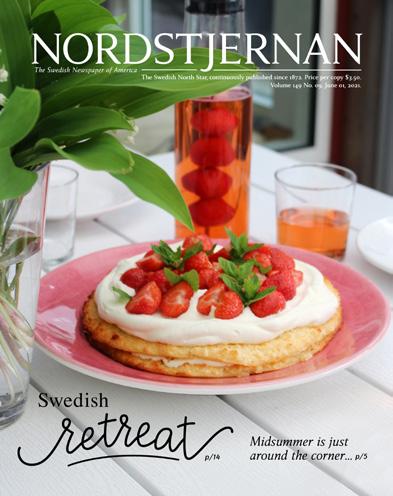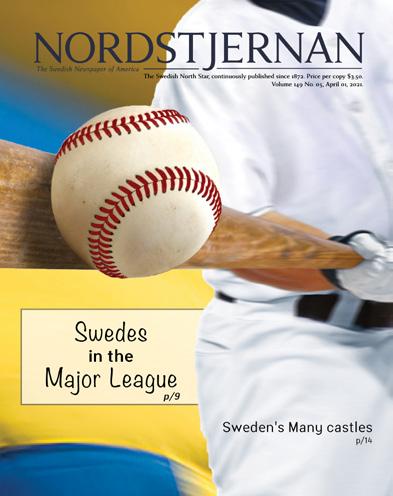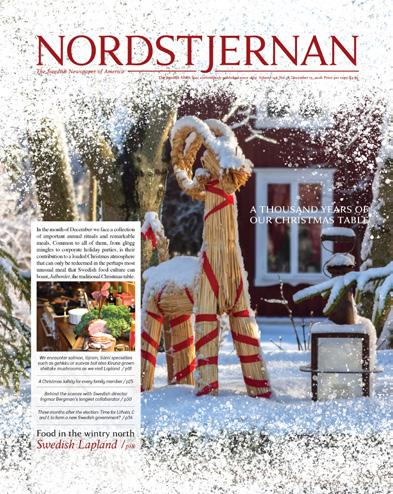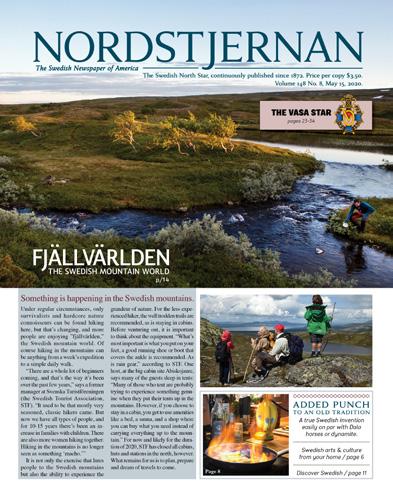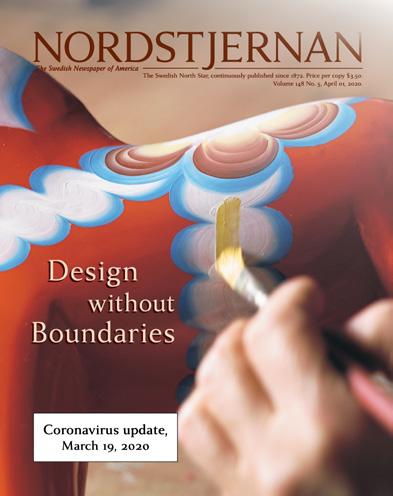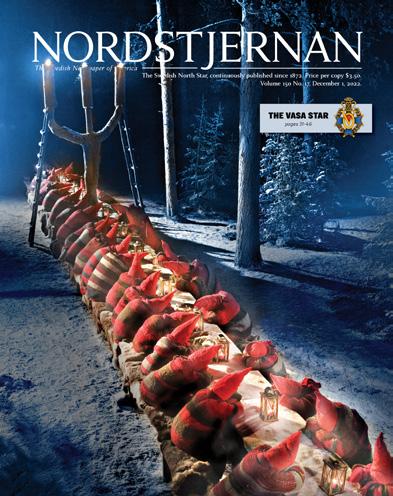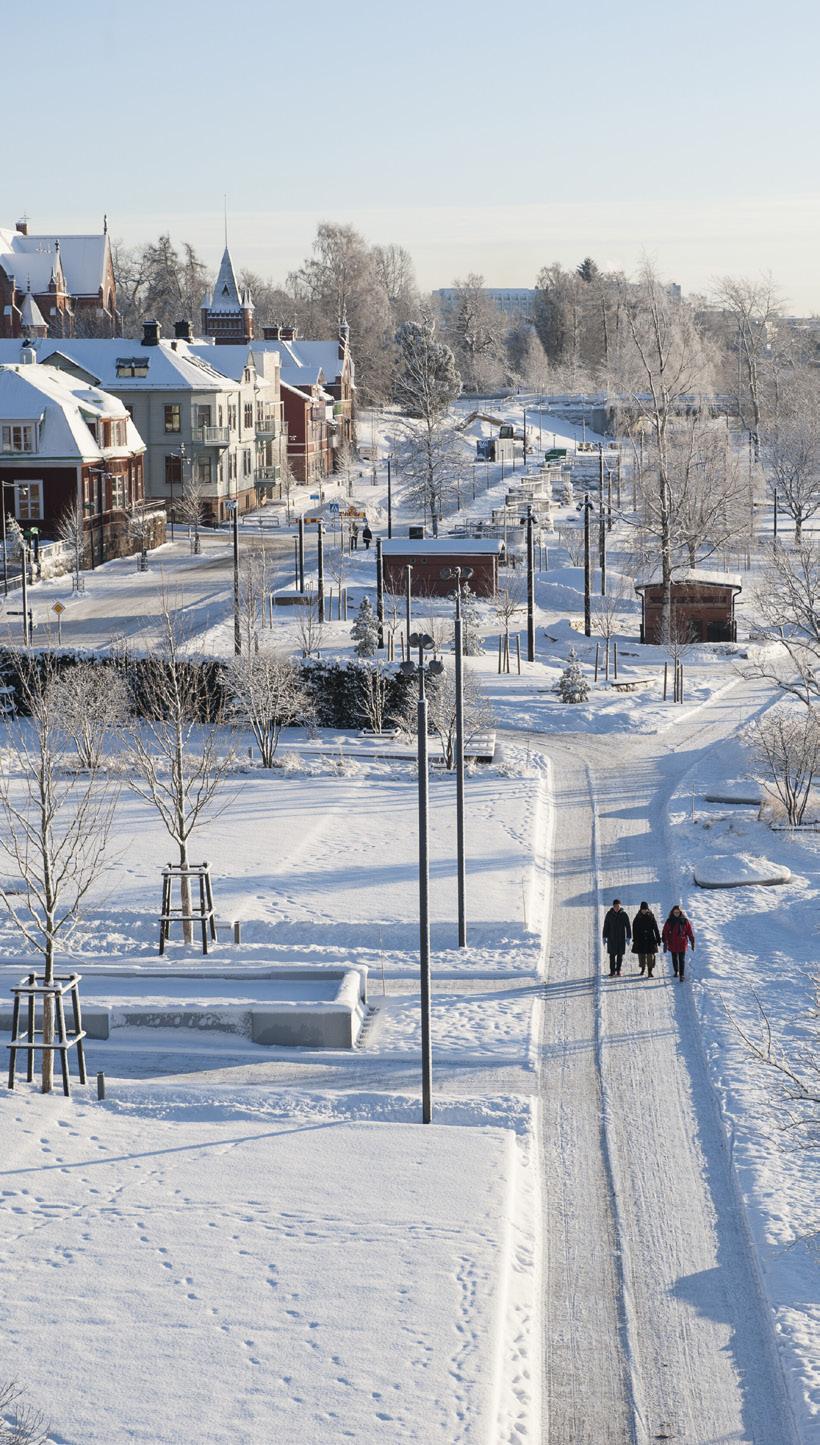
p/10 Iconic Stockholm structure turns 100
It may be cold and dark but already since December 21 the days are getting longer, light is returning and before we know it spring will be here.
Spring’s arrival in Sweden
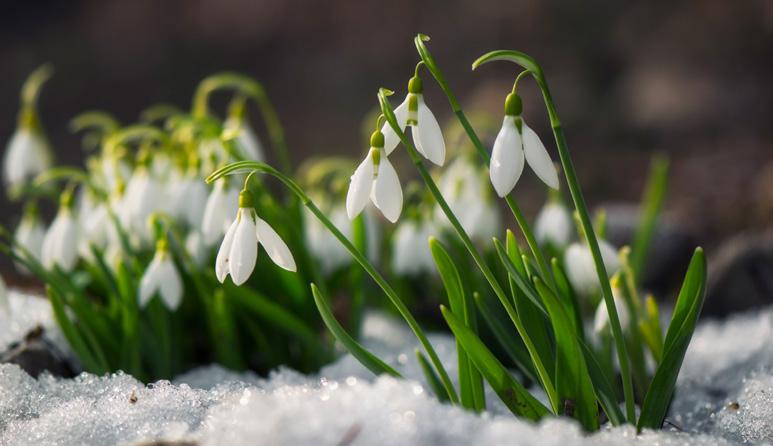
The Swedish Meteorological and Hydrological Institute (SMHI) has devised two rules of thumb over the years to determine the arrival of winter and spring. For the arrival of spring, average temperatures are required to rise above freezing for seven consecutive days. Normally, spring comes to the Dalarna region and further south in the second half of March. In midApril spring has also arrived in southern Norrland, and at the beginning of May winter is normally only remaining in the mountains.

February 01 Max/Maximilian
February 02 Kyndelsmässodagen
February 03 Disa/Hjördis
February 04 Ansgar/Anselm
February 05 Agata/Agda
February 06 Dorotea/Doris
February 07 Rikard/Dick
February 08 Berta/Bert
February 09 Fanny/Franciska
February 10 Iris
February 11 Yngve/Inge
February 12 Evelina/Evy
February 13 Agne/Ove
February 14 Valentin
February 15 Sigfrid
February 16 Julia/Julius
February 17 Alexandra/Sandra
February 18 Frida/Fritiof
February 19 Gabriella/Ella
February 20 Vivianne
February 21 Hilding

February 22 Pia
February 23 Torsten/Torun
February 24 Mattias/Mats
February 25 Sigvard/Sivert
February 26 Torgny/Torkel
February 27 Lage
February 28 Maria
SCANDINAVIAN QUIZ
In 1980, which country became the first of the current seven in the world to adopt full cognatic succession to the throne (in which the eldest child inherits the throne regardless of gender)?
A) Sweden B) Norway C) Denmark D) Luxembourg
2 Which country is not among the International Vasaloppet Skiing Exchange that hosts their own Vasaloppet during the winter months? A) USA B) Japan C) China D) Germany
3 What animal is the subject of many games during February’s Fastelavn Nordic Carnival? A) moose B) bear C) cat D) kraken
4 Swedish Army office Viktor Gustaf Balck organized not only the Nordic Games in the first half of the 20th century but also what major event? A) Vasaloppet B) The Winter Olympics C) Kicksled World Championship D) Changing of the Guard
5 What 2000-year-old relic recently found in Norway is probably the world’s oldest such item? A) embossed coin B) runestone C) wedding chalice D) Viking horn
CULTURE
6 What is (probably) the least used punctuation mark in the Scandinavian languages? A) exclamation point! B) semi colon C) parentheses D) comma
7 What is the meaning of “i ur och skur” for some Scandinavian schools’ teaching philosophy? A) learn from nature, whatever the weather B) question everything C) to err is human D) only one of the 3 Rs actually begins with R
8 Which northern country is the top coffee consumer? A) Finland B) Sweden C) Iceland D) Estonia
9 What sets apart Copenhagen’s Strøget from any other street in the world? A) It has the most water taxis B) it’s the longest pedestrian-only street C) it has folding panels that open ice lanes for hockey events D) every storefront has a hidden Lego brick
10 Who first used “Scandinavia” as a political term in the 19th century? A) King Charles XIV John B) Mormon missionaries C) university students D) U.S. President Ulysses S. Grant
Namnsdagar Februari
Yngve - February 11
Yngve is an Old Norse name, most probably the name of an unidentified god. It could also be an alternative name of the god Frej. According to Snorre Sturlason, the Icelandic author of the Prose Edda, Yngve was the first king of Sweden and his dynasty was named ynglingaätten after him. Today the name is most common among men over 50, and not always as a given name, more often as a middle name. The name Yngve had its glory days during the 19th century when all things Viking were popular.
Sigvard – February 25
The name Sigvard has been in use in Sweden since the 12th century, although Sigur was often more common. The name is combined by two words meaning “victory” and “watchman.” Birth of Prince Sigvard Bernadotte made the name popular.
founded in new york city in september 1872
dashboard | february 01, 2023 Nordstjernan (ISSN 1059-7670), founded in New York City in September 1872, is published by Swedish News, 570 Lexington Ave, new York, nY 10022 • Readers services and editorial submissions: P.O. Box 680, Minneola, FL 34755 Periodicals Postage paid at New York, NY, and additional mailing offices. www.nordstjernan.com, Nordstjernan is published semimonthly, except for the months of February, February, July when it is monthly and August with no issue.
POST MASTER: Please send address changes to Nordstjernan, P.O. Box 680, Minneola, FL 34755
Subscription rates: 1 yr. = $59, Two yr. = $106, Three yr. = $150.
Contact us at 1.800.827.9333, ext 10 for Reader services, ext 12 for Advertising www.nordstjernan.com • email: subs@nordstjernan.com, advertising@nordstjernan.com www.facebook.com/nordstjernan • www.twitter.com/nordstjernan www.instagram.com/nordstjernan • www.youtube.com/nordstjernan free digital newsletter www.swedentoday.com
2 NORDSTJERNAN
February 01 | Sunrise & Sunset New York 7.06 am 5.13 pm Chicago 7.03 am 5.05 pm Stockholm 7.58 am 4.04 pm Kiruna 8.55 am 2.50 pm Lund 8.01 am 4.40 pm Los Angeles 6.50 am 5.23 pm
Answers: 1:A, 2:D, 3:C, 4:B, 5:B, 6:B, 7:A, 8:A, 9:B, 10:C 1
Name’s Days of the Swedish Calendar Namnsdagar i Februari
February TO DO
02.02 CROSS FINGERS: “HÅLL TUMMARNA” (hold thumbs) - maybe the groundhog won’t see its shadow today.
02.06 RAISE THE SAMI FLAG: SÁMI NATIONAL DAY / Sámi everywhere celebrate by flying the flag, wearing the national costume, attending cultural events, eating national foods, and singing the national anthem.
02.06 BE THANKFUL FOR COMPUTER KEYS: SEMIKOLONETS
DAG / Semicolon Day reminds us that during the 1980s, Swedish typewriters required three keystrokes to create a semicolon and many therefore refused to use it; this could be why the semicolon is no longer used much in Swedish ...
02.14 SPREAD LOVE: ALLA HJÄRTANS DAG / Valentine’s Day has been recognized in Sweden since the 1960s. Celebrate with ... cardamom?
02.21 Have A SEMLA (if you didn’t already). It’s SHROVE TUESDAY: FETTISDAGEN (Fat Tuesday)

Actor Tom Hanks encountered his first a while back we hear (p5) ... a semla that is. We ran the recipe for semla in last year’s February issue but if you’re looking for a quick link, look at nordstjernan. com under FOOD. It’s listed at the top until February 28.
Nordstjernan is monthly in january-february. Your next issue will be dated March 1.





NORDSTJERNAN
18 issues per year
MAIL TO: P.O. Box 680, Minneola FL 34755 or CALL 1.800.827.9333 - ext 10

It’s never too late to make someone happy:
Order a gift subscription now, allow others to stay informed in a Swede way.
1 year: $59 ❏ 2 years: $106 ❏ Check ❏ Credit card ❏
Regular active subscribers: call or use your personal account data, received through the mail or online. (Vasa members, call!)
Please check if you are a new subscriber, this is a gift or you are renewing your present subscription
Renewal ❏ New subscriber ❏ Gift ❏
Name: __________________________________________
Address: ________________________________________
City: ___________________________________________
State: _______________________ Zip: ______________
Telephone: ________________________
Credit card#: __________________________ Exp: _____/_______
Signature______________________________________________
Stockholm City Hall turns 100 /p10
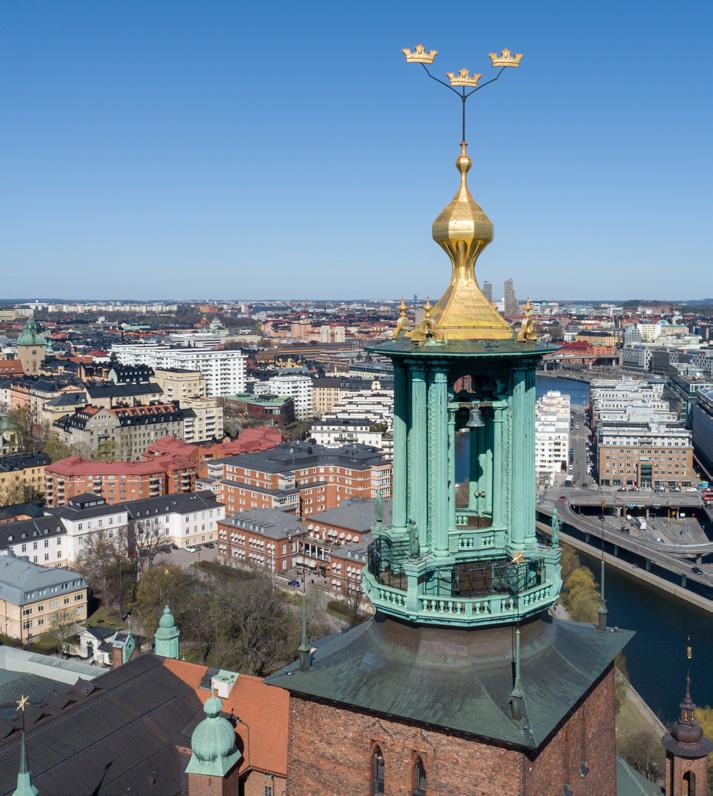
Dashboard, p4-5
Nationalmuseum forced to save / Large find of rare metals in Sweden / Sami protests / “Storm i ett vattenglas” / Gala opening for A Man Called Otto in Sweden / Swedish King on the change of succession.
Searching for “the real” Swedish nightingale
FEBRUARY 01, 2023 3 this week…
Exchange Rate: $1.00 = SEK 10.32
place in the world? p5 Page 9 Scandinavian Design & USA exhibit opens in Milwaukee, p8
The
(01.20.2023) Worst
Page 14
Nationalmuseum forced to save

The Swedish National Museum is forced to take several cost-saving measures this year. This means it will be closed one additional day each week - both Monday and Tuesday - and several exhibitions have been postponed. However, any layoffs of staff are not currently planned. Since the government compensation for free admission of SEK 12 million is disappearing from the museum budget, visitors over the age of 19 must again buy a ticket to enter it (and any state museum) as of the beginning of this year. The discrepancy is to be filled by ticket sales, but these revenues are not expected to be sufficient.
the news.
founded in new york city in september 1872
executive editor & publisher:
Ulf Barslund Mårtensson (editor@nordstjernan.com)
copy editor:
Amanda Olson Robison (editor@nordstjernan.com)
managing editor & production: Everett Martin
graphic design: Nadia Wojcik (design@nordstjernan.com)
contributors:
Ted Olsson - Leif Rosqvist - Martha Swanson
Kitty Hughes - Ulf Kirchdorfer - Valorie Arrowsmith
Bo Zaunders - Göran Rygert - James Kaplan - Gunilla Blixt
publications director:
Mette Barslund Mårtensson (mette@nordstjernan.com; 800.827.9333, ext 12)
nordstjernan p.o. box 680 minneola fl 34755 contact us at 1.800.827.9333 ext 10 for reader services, email: subs@nordstjernan.com; ext 12 for advertising, email: advertising@nordstjernan.com www.nordstjernan.com
Covering three worlds: Sweden, America and Swedish America. Order your own copy, $59.00 for a year (18 issues) Choose ‘subscribe’ at www.nordstjernan.com or call 1.800.827.9333, ext 10
Large find of rare metals in Kiruna
The mining company LKAB has made the largest find in Europe of rare earth metals. One million tons may be mined near LKAB’s existing mine in Kiruna. The company’s leadership has known about its existence for just over two years, but not its scope, so far only a small part has been examined. There were happy faces when LKAB and Minister of Economic Affairs Ebba Busch presented the news on January 12. The new finding means Sweden’s and Europe’s dependence on imports may decrease significantly in
the coming years; they have been predominantly supplied by China and to an extent Russia. And it is an important building block to cope with the so-called green transition, they stated. Rare-earth metals (or REE, rare-earth elements) are a set of 17 nearly indistinguishable lustrous silvery-white soft heavy metals. Compounds containing rare earths have various applications in electrical and electronic components, lasers, glass, magnetic materials, batteries and industrial processes.

Sami protests against mining plans
For Sámi reindeer herders in Gabna Sámi village, the mining news means something completely different than for the rest of Sweden, and the Sámi National Confederation and Sámi village are protesting against LKAB’s plans. Gabna is one of the most vulnerable Sami villages in Sweden because of encroachment and land exploitation. For over a century they have been strongly affected by LKAB’s activities - not only the mining itself but also because Kiruna’s new city center is located on their territory. If LKAB’s plans become reality, the Sami village risks being split in half. Then it is no longer possible to carry out traditional reindeer herding.
‘Storm i ett vattenglas’
Storm in a teacup: Justin Bieber vs H&M. In late December 2022 Justin Bieber called H&M’s clothing that featured his image “trash” and asked fans not to buy it. Taking to his Instagram Stories, the singer wrote: “I didn’t approve any
of the merchandise collection that they put up at H&M ... all without my permission and approval … SMH I wouldn’t buy it if I were you.” The clothing in question included a sweater dress with a black and white picture of him and a bag with multiple photos of him. “The H&M merchandise they made of me is trash. Don’t buy it,” a subsequent story posted to his 270 million fans stated. H&M reportedly told People Magazine in an interview, “As with all other licensed products and partnerships, H&M followed proper approval procedures.” Bieber has his own merchandise for sale on his official website, and a streetwear brand launched in 2019 called Drew. Two days after Bieber took to Instagram to call out H&M for selling products with his image on them, the Swedish retailer responded by pulling the pieces from stores, “Out of respect for the collaboration and Justin Bieber” according to a statement from the store.

4 NORDSTJERNAN dashboard | february 01, 2023
Palladium on the periodic table of elements, a rare metal named after the asteroid Pallas, with element symbol Pd and atomic number 46. It is a key component of fuel cells and used in catalytic converters.
Screen grab from Justin Bieber on Instagram
The stories, the traditions, the people behind
Photo: Tina Stafrén/imagebank.sweden
The Swedish King: “It was wrong to change the line of succession”
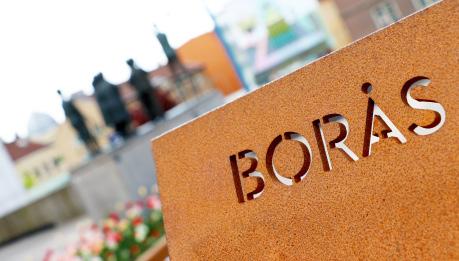
The Riksdag decision that changed the Swedish line of succession, from Prince Carl Philip to Crown Princess Victoria, was unjust, King Carl XVI Gustaf says in a new Swedish TV documentary. The constitutional amendment that made Sweden receive full cognatic succession to the throne – that is, that the eldest child inherits the throne regardless of gender – was initiated at the birth of Crown Princess Victoria. But the change did not take effect until a couple years later, after Prince Carl Philip was born into the role of Crown Prince in accordance with the earlier agnatic succession. It meant in practice that the succession to the throne was moved from one sibling to another.

In the documentary “Sveriges Sista Kungar” (Sweden’s last kings), the present king describes the decision as “tricky.”
“Having laws that work retroactively is not wise, I still think so. My son Prince Carl Philip was born and then suddenly they change so he gets rid of it all. It is rather strange, I think,” says the King. When asked if he thinks it was unfair, he replies: “Yes, I think so. As a parent, I think it’s terrible.” However, the king believes the change has been strengthening for the monarchy but that it should possibly have taken place before the next generational change. He adds the change has not led to any rifts between the siblings.
More houses for sale
During the first week of 2023, there were a total of 8,114 houses for sale on Hemnet, an increase of 125 percent compared to the same week in 2022. For apartments, the corresponding increase was 73 percent. The number of houses for sale has increased the most in Halland, up by a whopping 223 percent already in the first week of the year. When it comes to apartments, the increase is greatest in Västerbotten with 195 percent more for sale than last year. Assessors believe the high electricity prices may be one factor that makes people less interested in buying houses.
Madonna coming to Sweden
The pop icon will be in Sweden on October 28 for a concert at Tele 2 Arena. The Celebration Tour features her greatest hits and marks 40 years since the now 64-year-old singer released her debut album.
A Man Called Otto opened in Sweden
The U.S. film adaptation of A Man Called Ove was released in December 2021, and while not as understated as Lassgård in the original Swedishmade movie, actor Tom Hanks does a believable job as the curmudgeonly character Ove, or Otto, which is the character’s somewhat anglicized name. The U.S movie, a co-production, saw its wide theatrical release on January 13, 2023. Filmed in Ambridge, PA, one of the stronger nods to the story’s Swedish lineage comes as Hanks together with new Mexican neighbor,

Worst place in the world
played by Mariana Trevino, end up at Stangl’s Bakery to bond over semlor—which U.S. media explained as eclairs and sometimes Swedish creme bun (this beloved pastry thus gained a few more names). Stangl’s is a long time bakery in the area just outside Pittsburgh, and while Hanks clearly massacres his semla in the movie, the real-life store’s proprietor is reportedly considering putting the item on the menu. Are you in or near Pittsburgh? Do let us know if and how well it compares with its Swedish original. /Ed.
Dystopian clips with the text “Only in Borås” spread like wildfire on Tiktok in the fall of 2022. The images were not from Borås, but the city nevertheless became a symbol of the world’s worst place. As a counterweight, the municipality created a Tiktok account where they posted their own clip in which a city manager showcased Borås’ public art. The municipality’s clip has over 160,000 views on Tiktok, while for instance the opening dystopian clip made by a 15-year-old has 4.3 million. The hashtag Borås now has over 300 million views.
New Swedish laws At the turn of the year, several changes took place that affect Swedes’ private finances. Certain benefits that were temporarily raised during the pandemic and that would have been restored will remain at the higher level in 2023. Among other things, this applies to unemployment insurance and a temporary additional benefit for families with children with housing benefits. The 700,000 Swedish households that own a cat must register it with the Swedish Agricultural Agency. Registration costs SEK 40 ($4). Older employed people who want to continue working have the right to work until the day they turn 69 (an increase of one year). At the same time, the minimum age for drawing income-based retirement pension is raised from 62 to 63 years. The minimum age to receive a guaranteed pension is simultaneously raised from 65 to 66 years.
FEBRUARY 01, 2023 5 dashboard | february 01, 2023
Photo: Linda Broström/The Royal Court of Sweden
Photo: Mathias Blom/SF Studios
The gala premiere in Sweden on December 13 of the U.S. film adaptation A Man Called Otto. The event was attended by leading actor Tom Hanks and supporting actor Mariana Treviño together with director Marc Forster and producers Rita Wilson and Fredrik Wikström Nicastro. From left to write: Michael Porseryd, then CEO of SF Studios, Fredrik Wikström Nicastro, producer SF Studios, Rita Wilson, producer, and the two main characters Rolf Lassgård (Ove), Tom Hanks (Otto) and Christina Jeurling Birro, journalist.
Hans Majestät Konungen / His Majesty The King, Carl XVI Gustaf. Photo: Linda Broström/The Royal Court of Sweden
Local Events
Illinois
Rock Island
Feb 13, 6-7 PM
Nordic Book Club – Discuss So Much Longing In So Little Space: The Art of Edvard Munch by Karl Ove Knausgaard. Joint program via Zoom with Figge Art Museumn, Swenson Swedish Immigration Research Center, www.swensoncenter.org/events
Chicago
Jan 28, 1 PM
Book Club Online: Free, get Zoom meeting info and register via email museum@samac.org. Swedish American Museum, 773.728.8111 / www. swedishamericanmuseum.org

Ongoing
The Brunk Children’s Museum of Immigration has reopened! Located on the third floor of the Swedish American Museum, this special room offers children the chance to experience immigration firsthand. Get on board a 20-foot immigrant steamship for a journey to America, and learn about life in a pioneer log cabin. Admission to the Brunk Children’s Museum of Immigration is free with Swedish American Museum general admission. 773.728.8111 / www. swedishamericanmuseum.org
A new spin on tradition
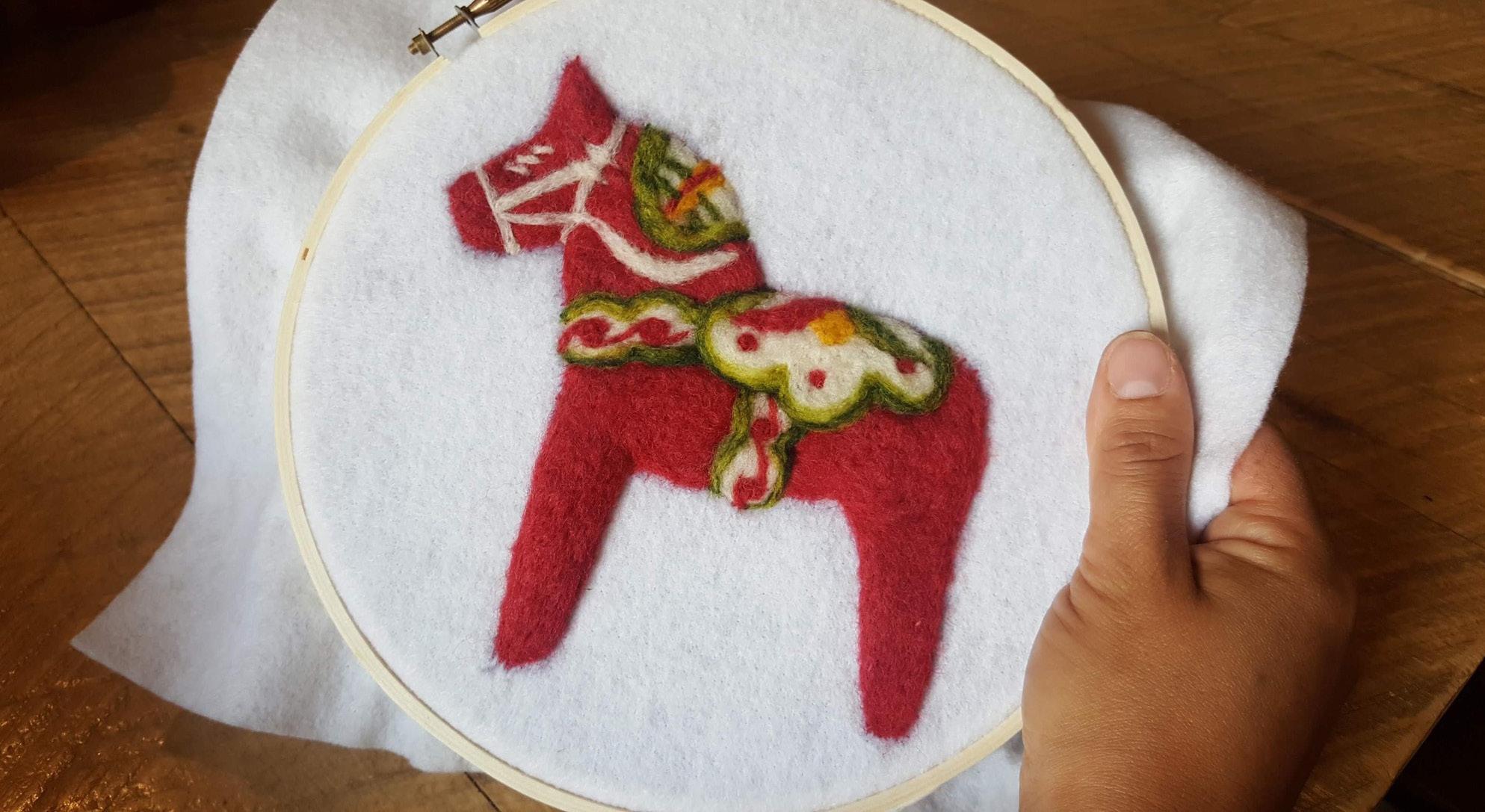
Dala horses have been a Swedish icon for centuries, the inspiration for many cultural connections with Sweden. Now Scandinavia House in New York is offering a virtual opportunity for you - no matter where you are -- to put a new spin on the traditional wooden-painted form by recreating the image in wool. In the Painting with Wool, a Virtual Dala Horse Needle Felting Workshop, on February 18 at 11 AM-2 PM EST, you can learn (or master) the magic of needle felting a Dala horse. Learn to
Ongoing
Nordic House: This special installation in the historic Wrigley Building in downtown Chicago provides visitors with an immersive experience of the Nordic region – with images and videos as well as the best of what the respective Nordic countries have to offer in retail products, food and culture, and a photography exhibit by Hans Ekestang. Wrigley Building’s South Tower at 400 N. Michigan Ave. www.swedishamericanmuseum. org/nordic-house
Massachusetts Taunton
Feb 11, 8 PM
SAN FRANCISCO
stretch felt backing and keep it tight for ease of use, and transform a beautiful array of hand-dyed roving from the instructor’s Hayward, WI farm sheep into your project. Focus will be given to shape creation, colorwork, and three-dimensionality.This is a beginner-friendly course. Bring your creative spirit and love of wool! Get more information about what you need to provide and what’s included in the fee at Scandinavia House, 212.779.3587 / www.scandinaviahouse.org
ABBA Valentine’s Day Dance with Dancing Dream - The Tribute to ABBA goes on a nostalgic trip back to the glitz and glamour of the 70s with the harmonies, elaborate costumes, and exciting choreography of ABBA. At The District Center for the Arts, www.dancingdreamtribute.com/tour
West Newton
Feb 4, 1 PM
A Modern Swedish Architect in America: This lecture goes in depth to explain the work of Swedish architect Martin Hedmark who came to the United States in late 1924 to launch his career. Learn about Hedmark’s design for Gloria Dei Lutheran
Church in Providence and other projects in New York, Worcester, Philadelphia and New Jersey. Scandinavian Cultural Center, 617.795.1914 / www.scandicenter.org
Feb 11, 1:30 PM
Food and Romance: See this movie from Sweden, Food and Romance, in which a sudden change forces Karin to re-evaluate her life. With the help of friends, food and passion, she refuses to accept that life has an expiration date and takes the second chance she is given. In Swedish with English subtitles. $5-$10, Scandinavian Cultural Center, 617.795.1914 / www. scandicenter.org
Feb 18, 1 PM
Oskar Stenmark in Concert: Born and raised in Gothenburg, Sweden with a rich musical heritage, Stenmark is now based in New York and returns to Scandinavian Cultural Center with new music, original compositions and the premiere of a new project with ties to his family history. $7-$15. kerry@scandicenter. org / www.scandicenter.org
Söndag 12 frebruari kl 11.00 SVENSK GUDSTJÄNST
i San Francisco med efterföljande kyrkkaffe. Lördag 18 februari kl 15.00 SVENSK GUDSTJÄNST
i Los Altos med efterföljande kyrkkaffe.
För mer info om barnsång, unga vuxna middag, veckomässa, m.m. se vår hemsida, www.svenskakyrkan.se/sanfrancisco
SVENSKA KYRKAN SAN FRANCISCO
Norska Sjömanskyrkan, 2454 Hyde Street, San Francisco Tel: 415-632-8504 Epost: sanfrancisco@svenskakyrkan.se Hemsida: www.svenskakyrkan.se/sanfrancisco
Minnesota Minneapolis
Feb 3, 10-11:30 AM
Preschool Program: Kicksledding on the Lake - Hop on a kicksled on Silverwood Park’s frozen lake – an exciting pastime and mode of transportation with a Swedish origin. Warm up with a story around the fire and create your own colorful snow paintings in nature using natural materials. For ages 3-5 and their important adults. Meet in the White Oak Classroom building at Silverwood Park, www.asimn.org
NORDSTJERNAN
6
local
events
Photo: Laura Berlage, artist and instructor, Erindale Tapestry Studio.
Feb 8, 5:30-8 PM
Virtual Workshop: Braid and finish a beautiful bracelet inspired by the Sámi art of tenntråd, or pewter wire art. Receive a kit with all the materials to make a bracelet out of natural materials including pewter wire, reindeer leather, and an antler button, plus a reusable clamp for future braiding projects. For ages 16+. This is a live virtual class taught over Zoom. American Swedish Institute / www. asimn.org
Feb 17 & 18, 9-10 AM
Kids at the Castle: This actionpacked creative playtime encourages adventurous young minds through circle time, storytelling, crafts, visual play, music, and movement with February’s theme of Hearts & Hugs. For ages 2-5 and their grown-ups. American Swedish Institute / www.asimn.org
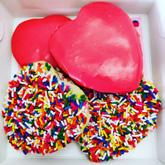

Feb 9, 1-2:30 PM CST
Virtual Demo - Baking Swedish Semlor: Pick up tricks for making this popular pastry by watching Kristi Bissell bake a batch of cardamom and almond flavored semlor in this virtual demonstration. American Swedish Institute / www. asimn.org
Feb 17 & 18
Midwinter Folk Festival and Concert: Enjoy this winter weekend of song and art - on Friday at 6 PM, attend the festival kickoff concert featuring New York-based Nyckelharpa player Alyssa Rodriquez. All day Saturday are opportunities to attend concerts, workshops, dance and drop-in musical opportunities. The art of folk music – both new and old – is shared through music-learning opportunities for children and adults, and the weekend culminates in a group play-along finale. If you’ve ever wanted to learn more about a nyckelharpa or a spelmanslag, this is your chance. See the schedule and register at www.asimn.org/experience/festivals/ midwinter-folk-festival
Mora
Feb 5-11
Vasaloppet USA Ski Race: Enjoy an entire week of winter activities that culminate in a weekend with a variety of race opportunities for all ages: the Vasa, the Classic, the Dala, the Bell Ringer, the Team, Fat Tire, Skijoring and the Miniloppet. See the schedule and register at www. vasaloppet.us
New Hampshire Manchester
Feb 10, 8 PM
The Best of ABBA with Dancing DreamThe Tribute to ABBA goes on a nostalgic trip back to the glitz and glamour of the 70s with the harmonies, elaborate costumes, and exciting choreography of ABBA. At The Palace Theatre, www. dancingdreamtribute.com/tour
New York
NYC
Feb 7, 6-7 PM
Online Nordic Book Club: Read and discuss Scandinavian literature in translation – on The Reindeer Hunters by Lars Mytting, a novel about love and bitter rivalries, sorrow and courage, and a world with a mythic and mystical undercurrent battling the pull of the future. The second in Mytting’s Sister Bells trilogy. Scandinavia House, press@amscan.org / www.scandinaviahouse.org
Feb 16, 7-8 PM
Book Talk: Author Lisa E. Bloom discusses her new book Climate Change and the New Polar Aesthetics: Artists Reimagine the Arctic and Antarctica. Bloom considers the ways artists, filmmakers, and activists engaged with the Arctic and Antarctic represent our current environmental crises and reconstruct public understandings of them. Books available for purchase and signing at a discount for attendees. Scandinavia House, press@amscan.org / www.scandinaviahouse.org
Feb 18, 11 AM-2 PM
Painting with Wool, a Virtual Dala Horse Needle Felting Workshop: Explore the magic of needle felting with a delightful Dala horse image and take your colorwork skills to a new level. Learn to stretch a felt backing onto an embroidery hoop and keep it tight for ease of use, and transform your own project. Get more information about what’s needed provided at Scandinavia House, 212.779.3587 / www.scandinaviahouse.org
Ongoing
Play Sessions: The very popular Heimbold Family Children’s Playing & Learning Center has reopened for 90-minute free-play sessions that integrate early childhood sensory perception with the best of Scandinavian design. ASF Family Members should reserve a time online, www.scandinaviahouse.org/playinglearning-center. More info at Scandinavia House, 212.779.3587 / info@amscan.org
Oregon
Portland
Feb 12, 2-5 PM
Fastelavn: Celebrate the Carnival season the Nordic way with this family-friendly afternoon of crafts, games, fastelavnsboller, snacks, beverages, hilarities and a costume contest. Nordic Northwest, 503.977.0275 / www. nordicnorthwest.org
Feb 14, 6:30-8:30 PM
A “Sweetheart” of a Danish Dinner: Explore Nordic food traditions in this class taught by Broder Söder Executive Chef Aaron Franco as he prepares Frikadeller (Danish meat balls), Brunede Kartøfler (Sugar glazed potatoes) and Rødkål (red cabbage). Nordic Northwest, 503.977.0275 / www.nordicnorthwest.org
Feb 17, 1-2 PM
Family Storytime and Craft: Weathering
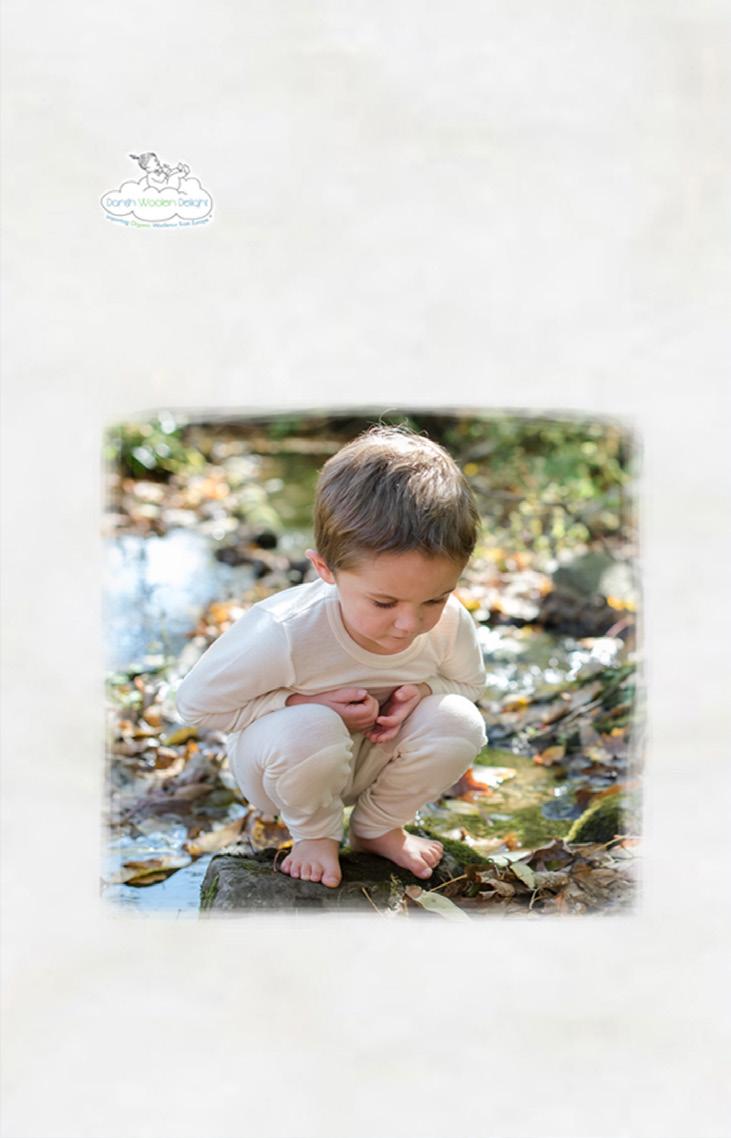
Winter! We will read a traditional Nordic tale or a contemporary Nordic story about the season and work together on a craft that ties into the story. Adults must stay with children during this event.
Nordic Northwest, 503.977.0275 / www. nordicnorthwest.org
Feb 18, 7-8 PM
Concert: Flute Fantasy with NW Edvard Grieg Society. During his life, Edvard Grieg (1843- 1907) acted as an ambassador for Norwegian music to the rest of the western world, bringing the Norwegian sound beyond folk music and into the
mainstream of art music to mainland Europe. Nordic Northwest, 503.977.0275 / www.nordicnorthwest.org
Ongoing
Nordic Coffee Hour: Every Tuesday at 10-11:30 a.m. you can enjoy Kahvitunti / Fika / Kaffeehygge - a cup of coffee with friends old and new at Nordia House. This new pilot program welcomes everyone, whether you’re Nordic or just interested in Nordic culture. Nordic Northwest, 503.977.0275 / www.nordicnorthwest.org
DANISH WOOLEN DELIGHT
Importing Organic Woolens+ from Europe for entire family
Baselayers in wool & wool -silk blends Balaclavas & Hats for all ages … & more
LOS ANGELES
Fredag 3 februari
info@danishwool.com
802-878-6089
FREDAGSMIXER Morgonbön, bibelstudium, kvällsandakt. Söndag 5 februari kl 11.00
GUDSTJÄNST
i San Pedro. Tacklunch för volontärerna efter gudstjänsten.
Fredag 10 februari
FREDAGSMIXER—Morgonbön, bibelstudium, kvällsandakt. Fredag 17 februari kl 18.00
Lördag 18 februari kl 18.00
GUDSTJÄNST
i Corona Del Mar, Orange County.
Fredag 24 februari
FREDAGSMIXER—Morgonbön, bibelstudium, kvällsandakt. Ärtsoppa och semlor.

FREDAGAR I SAN PEDRO
Kl 10.00 Morgonbön, kl 14.00 bibelstudium, kl 19.00 Kvällsandakt.
CHURCH OF SWEDEN, LOS ANGELES
1035 South Beacon Street, San Pedro, CA 90731 Tel. (310) 292-7080 • Epost: losangeles@svenskakyrkan.se Hemsida: www.churchofswedenla.com
FEBRUARY 01, 20 23 7 local events
Use code NORDSTJRN20 for 20% off full-priced items
Danishwool.com
Ongoing
New Nordic Cuisine. This exhibition focuses on a Nordic value-driven food system that has captured the attention of world-famous chefs and home cooks alike over the past 15 years. By examining Nordic food trends in a light-hearted, interactive format, this exhibition introduces visitors to contemporary Nordic food and its driving values today. Through March 27 at Nordic Northwest, 503.977.0275 / www. nordicnorthwest.org
Pennsylvania
Philadelphia
Feb 10, 12 PM
Virtual Field Trip Friday: Take a break to get immersed in the Birger Sandzén Memorial Gallery in Lindsborg, Kansas. This virtual field trip is 45 minutes long and presented over Zoom. $5-$10. American Swedish Historical Museum, 215.389.1776 / www. americanswedish.org / www.sandzen.org
Feb 11, 11 AM
Semlor and a Movie: Treat yourself to a rich semla (a cream and almond paste-filled Swedish pastry) with a cup of hot coffee and a Swedish movie. Semlor are often eaten before lent, the Swedish version of “Fat Tuesday.” Event tickets are $13 in advance and $15 at the door. Ticket price includes one semla- additional semlor are
$6 each. Walk-ins are welcome or preregister by February 8. American Swedish Historical Museum, 215.389.1776 / www. americanswedish.org
Through Feb 19
Art for All Exhibition: The Swedish Experience in Mid-America, featuring paintings and sculptures by Swedish American artists from the late-19th and early-20th centuries. American Swedish Historical Museum, www. americanswedish.org
Feb 21, 10:30 am
Toddler Time: Friendship Fabric - This month families can explore the exhibition, Weaving A New Chapter, and learn about the meaningful textiles immigrant families brought from Sweden. We will read “Wild Rose’s Weaving” by Ginger Churchill and practice fine motor skills with our weaving activities. American Swedish Historical Museum, 215.389.1776 / www. americanswedish.org
Washington
Seattle
Feb 9-12
5th Annual Sámi Film Festival: Explore Sámi stories through film in this mustsee hybrid event taking place both inperson and virtually! Attendees can
screen films online on February 9-12 and in person at the National Nordic Museum in Seattle and Scandinavia House in New York on February 11. The focus of this year’s festival is the work of female Sámi directors and includes a variety of contemporary documentaries, short films, and panel discussions with the filmmakers. National Nordic Museum, 206.789.5707 / danal@nordicmuseum. org / www.nordicmuseum.org
Feb 9, 6-7:30 PM
Scand30: 1 Object - During the month of sweethearts and heartaches, join University of Washington’s Olivia Gunn as she explores the practicalities of pairing off in modern Norway. The popular Scand30 series uses an object in the museum’s collection as a point of departure for the speaker’s topic. A light reception follows the presentation. National Nordic Museum, 206.789.5707 / www.nordicmuseum.org
Feb 16, 6-7 PM
Virtual Crafts & Cocktails: Recharge from your day with an evening of creativity and fun! Learn a cocktail recipe, and make something special using supplies from around the house. National Nordic Museum, 206.789.5707 / www. nordicmuseum.org
Feb 24, 6-8 PM
Fact & Fiction Film Series: Frozen II - It’s been a few years since Frozen and Frozen II took the world by (snow) storm. But did you know that many elements of Frozen II are inspired by Sámi culture? Disney entered into a contract with Sami parliaments in Finland, Norway and Sweden and the Sami Council “to ensure that the content of Frozen II is culturally sensitive, appropriate, and respectful of the Sami and their culture.” Join us for a screening of Frozen II, and a lecture on the inspiration that Disney took from Sámi culture! National Nordic Museum, 206.789.5707 / nordic@nordicmuseum. org / www.nordicmuseum.org
Scandinavian Design & USA opens in Milwaukee
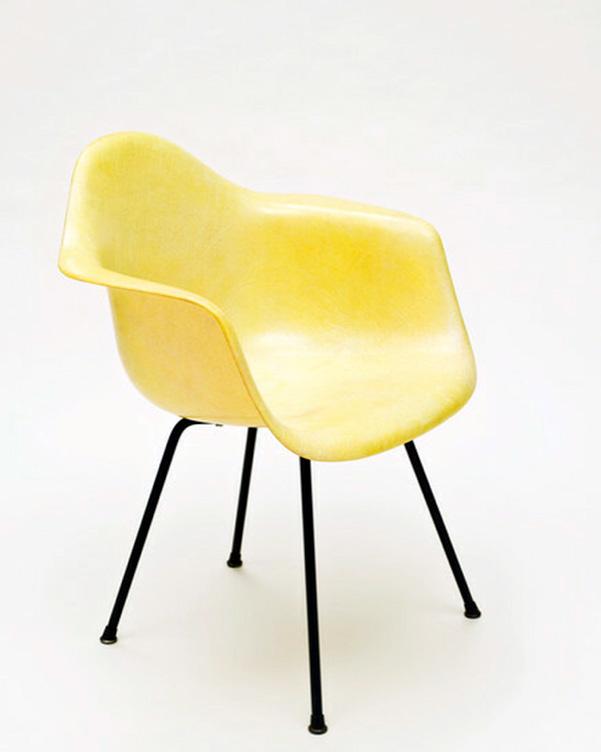
The exhibition Scandinavian Design & USA is presently (until February 5) showing at the Los Angeles County Museum of Art. It opens again on March 23 at the Milwaukee Art Museum, examining how concepts and design from the Nordic countries influenced and shaped modern American design, and conversely how concepts from the United States have influenced Nordic design. It is an international collaboration between the Los Angeles County Museum of Art, the Milwaukee Art Museum, Nationalmuseum in Stockholm and Nasjonalmuseet in Oslo. The exhibition’s first stop was Nationalmuseum in Stockholm in 2021 and the turn is coming for the Cream City’s iconic Calatrava designed art museum.
For the first time, the relationship between Scandinavian and American design in the 20th century is the subject of an exhibition. Scandinavian Design & USA – People, Encounters and Ideas, 1890–1980 is the product of international collaboration between museums and new research. Exhibited are more than 300 artifacts from collections in the United States and Scandinavia. Visitors can learn about the trends that shaped the design aesthetic, identity
and philosophy that we encounter to this day. Among the topics examined are the significance of Scandinavian emigration and the large-scale marketing campaigns for Scandinavian Design in the United States in the 1950s.
When the term was coined in the 1950s and promoted worldwide, Scandinavian Design referred to contemporary design from the Nordic countries. In the political and economic spheres, the concept became a brand embodying the traditions, culture, natural heritage and democratic values of Scandinavia. Although genuine to a certain extent, the concept is contentious, and the exhibition therefore reveals a multifaceted design history reaching back much farther. Examples that stand out include airline advertisements featuring a Viking, the industrial design of new household goods, and finely crafted silverware for the new cocktail culture. Other examples that illustrate the widespread appeal of the concept include interior furnishings for the United Nations headquarters and upscale private residences, and car interiors featuring woven textiles.
Many Scandinavian influences can be found in American design, and America has likewise had a big impact on the Nordic design scene. Eliel Saarinen, Carl Milles, Alvar Aalto, Charles Eames
8 NORDSTJERNAN local events
Charles Eames, DAX Chair.
Photo: © Museum Associates/ LACMA
and Eero Saarinen are just some of the influential thinkers who left their mark on design trends and design schools in 20th-century America. (One of Eero Saarinen’s masterpieces, the innovative War Memorial Center built in 1955, shares connecting space with the Milwaukee Art Museum.) The exhibition also considers how the American perspective reached Scandinavia, and how the Nordic countries used design as a diplomatic tool. So did the United States, especially in the postwar period, when architecture, art and design served as manifestations of America’s superpower status. American touring exhibitions were dispatched as a form of public diplomacy, and when embassies and official residences were built and furnished, architecture and design were used to promote American values and political positions.
The story begins at a time when transatlantic contact primarily involved migration from Scandinavia to the United States. Starting in the late 19th century, some three million people emigrated from Denmark, Finland, Sweden and Norway. When people migrate, ideas and skills migrate with them. Traditional craft skills were kept alive in the settlers’ new homeland and passed on to later generations. Many migrants took jobs in manufacturing and brought new knowledge to the American consumer culture. Around the same time, Scandinavian folk art, handwoven textiles and Norwegian stave churches appeared alongside international industrial design at the world’s fairs in Philadelphia and Chicago. After immigration to America tapered off in the 1920s, exchanges of ideas between Scandinavia and the United States influenced developments in design. Trade and travel increased. Touring exhibitions and trade fairs paved the way for new ideas, lifestyles, cultures and worldviews. Concepts such

as “the Scandinavian look” and Swedish Modern gained publicity and popularity through coverage in the mass media. The story ends at a time of change for the design scene, due to the emergence of other nations such as Italy and Japan, coupled with increasing globalization.

Scandinavian Design & USA – People, Encounters and Ideas, 1890–1980 is on show in the Baker/Rowland Galleries at Milwaukee Art Museum from March 24 until July 23, 2023. Curators are Bobbye Tigerman at the Los Angeles County Museum of Art, Monica Obniski at the Milwaukee Art Museum, Helena Kеberg at Nationalmuseum, Stockholm and Denise
Hagstrцmer at Nasjonalmuseet in Oslo. The exhibition was made possible by major grants from the Terra Foundation for American Art (international tour and exhibition sponsor) and the Henry Luce Foundation (presenting sponsor). Generous support is also provided by Nordic Culture Point.
For more info, see www.lacma.org/art/ exhibition/scandinavian-design-and-unitedstates-1890-1980 (Los Angeles) www.mam.org/ exhibitions/scandinavian-design (Milwaukee)
FEBRUARY 01, 2023 9 local events
Sidney Waugh, Gazelle Bowl. Photo © The Metropolitan Museum of Art/Art Resource New York/Scala, Florence
First sight of New York, cotton tapestry © Lillian Holm; Photo: © Flint Institute of Arts
STOCKHOLM CITY HALL
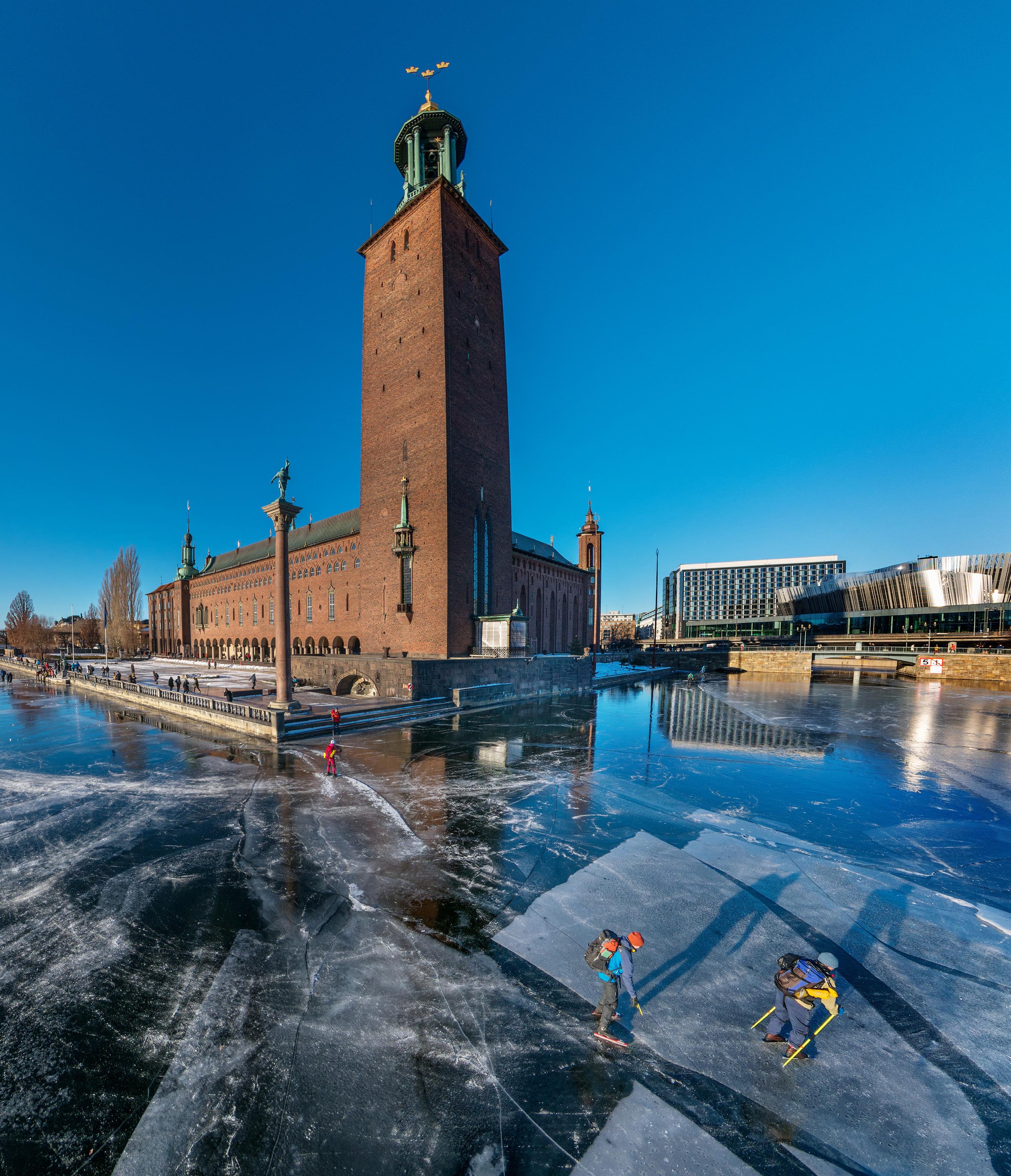
Iconic structure, a strong symbol and center of local political power in Sweden’s capital.
Midsummer’s Eve, June 23, 2023 marks the 100th anniversary of the building’s inauguration.
10 NORDSTJERNAN feature
Photo: Jann Lipka/imagebank.sweden
The Stockholm City Hall is the building of the Municipal Council for the City of Stockholm, a Renaissance Palace for the People. It sits on the eastern tip of Kungsholmen island, next to Riddarfjärden’s northern shore and faces the islands of Riddarholmen and Södermalm.
The following description of the district was made in a motion to the city council in 1892.
“Kungsholmen is to some extent still the subject of an old prejudice among the inhabitants of other districts in Stockholm, which will eventually disappear over time.”
Over time, though, the area developed into one of the most well known and beautiful parts of the inner city of Stockholm.
City Hall houses offices and conference rooms for the City council members as well as ceremonial halls, and the luxury restaurant Stadshuskällaren. It is the venue for the annual Nobel Prize banquet and is one of Stockholm’s major tourist attractions.
At first glance
On top of the tower I see the three crowns that are symbol of Sweden, and appears on outfits for various sports, especially ice hockey known here in the USA.
There are two theories about the crowns. One is that the crowns stand for Denmark, Sweden and Norway. Another is that they stand for the three original Swedish counties: Östra Götaland, Västra Götaland and Svealand. I’m standing in the front of the building, and it is enormous, to say the least. The construction took 12 years, from 1911 to 1923. Nearly eight million red bricks were used. The dark red bricks, called “munktegel” (monk bricks) because of their traditional use in the construction of monasteries and churches, were provided by Lina brick factory near Södertälje. Construction was carried out by craftsmen using traditional techniques. The building was inaugurated on June 23, 1923 (exactly 400 years after Gustav Vasa’s arrival in Stockholm) with celebrity author, poet and Nobel laureate Verner von Heidenstam and the first social democratic Prime Minister Hjalmar Branting, who delivered the inauguration speeches.
The tower is the overall dominating feature at 106 meters high (about 350 feet), and to reach the top you have to climb 365 very steep steps. This will be my first effort. From the tower lookout I have a wonderful view of Riddarholmen (Knight
Island) and Gamla Stan (Old Town) toward the east by the shimmering water of Lake Mälaren.
Entering
Descending from the City Hall Tower, I enter into the Blå Hallen (Blue Hall). The hall is 50 meters (160 feet) long, 30 meters (98 feet) wide and 22 meters (72 feet) high and has a floor space of 1,500 square meters (16,000 square feet). It contains a monumental staircase and balcony, and a bust of the architect of the hall, Ragnar Östberg, is placed on the hall’s rooftop terrace.
The Blue Hall has the monk brick walls which are not plastered. The hall was originally supposed to have been plastered and painted blue, a color scheme that would have resembled the water of Lake Mälaren. But Östberg changed his mind during the construction of the hall after he saw the impact of the red bricks. Though Östberg abandoned his blue design in favor of the unfinished red brick, the name “Blue Hall” was already in general use and stuck.
The hall is the site of the well-known annual Nobel Banquet held every December 10. This banquet is “the most sought-after social invitation in Sweden,” attended by the Swedish Royal Family, government ministers, parliamentarians and over 1200 invited guests. Following the banquet, guests retreat to the Golden Hall for dancing. The Nobel Prizes are not handed out in the Blue Hall but are awarded during an earlier ceremony at the Stockholm Concert Hall at Hötorget (Haymarket Square) in the city center.
On this day each year the S:t Eriksmedaljen (St. Erik’s Medal) is given to awardees at the Blue Hall. The hall is also used for state visits, student graduations (including my own), balls and other large events.
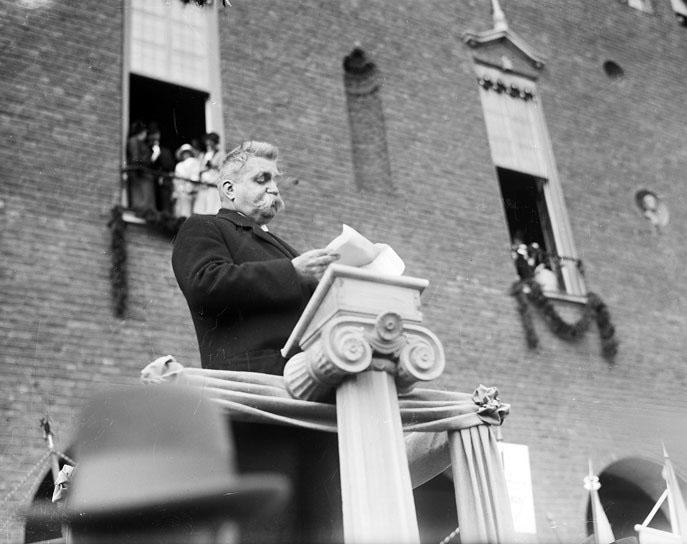
From blue to golden
As a young man I went to Saturday night dances at the Blue Hall with my friends. We danced to “Dixieland” (traditional jazz) music inspired by British musician Chris Barber and swing-inspired bands like Carl Henrik Norin’s orchestra, among many other good dance bands of the time. Walking around in the Blue Hall awakens many fun memories from the time when I was a young man. I also recalled the enormous organ in the Blue Hall with its 10,270 pipes, I think the largest in Scandinavia, and I heard it played once and the whole building was vibrating from the music. It was quite exciting.
Above the Blue Hall is the Gyllene Salen (Golden Hall), named after the decorative golden mosaics made with more than 18 million tiles, and the mosaics make use of motifs from Sweden’s glorious ancient history. The Golden Hall really is golden and almost overwhelming. On the opposite wall across the hall is the picture of the most beautiful Mälardrottningen (Queen of Lake Mälaren) representing the beautiful city of Stockholm. Mälardrottningen is a nickname that has existed at least since the late 1800s and refers to the city’s dominant location at the eastern part of Lake Mälaren.
Seat of local government
From the Golden Hall I proceed to the beautiful City Hall (Rådsalen) where the municipal assembly with 101 members conducts their meetings.
The municipality is subdivided into 14 districts. These districts are sometimes incorrectly referred to as “boroughs” in English. They are, however, not legal entities or separately run communities but committees of the municipality itself. These districts are administered by stadsdelsnämnder (district councils), which carry responsibility for primary school, social, leisure and cultural services within their respective areas. The members of these councils are not directly elected by the inhabitants of the respective districts, but rather appointed by the kommunfullmäktige (municipal assembly).
The room is very impressive, suited for the most
FEBRUARY 01, 2023 11
Then Prime Minister Hjalmar Branting speaking at the inauguration in 1923.
powerful Stockholm assembly. I’m especially impressed by the ceiling with its timber joists built like an old wooden ship in an upside down position.
In order to give the timber work the credit it deserves I’m lying on the floor to get a good picture — to many tourists’ surprise and alarm as it could be seen as some sort of freaky accident.
After I rise, I exit the room and capture a glimpse of other tourists imitating my own impressive performance earlier.
By Lake Mälaren
There is so much more to see, but in saving time I exit the building toward Riddarfjärden into a small park between the building and Lake Mälaren’s shore. The park is adorned with several sculptures, among them Carl Eldh’s ensemble of several famous Swedish authors as well as Eldh’s bronze sculptures “Sången” and “Dansen” (“The Song” and “The Dance”). To the southeast of the City Hall, facing Riddarholmen, is a pillar roughly 20 meters (>65 feet) high with a tall statue of Engelbrekt Engelbrektsson on top. He was a Swedish rebel leader and statesman, leading the rebellion against the Kalmar Union in 1434.
On the east side toward Tegelbacken I find a well-known “Cenotaph of Birger Jarl” where my grandfather took us children for Sunday walkabouts. We were always jokingly told that Birger Jarl, the founder of Stockholm, was buried here,
Another renowned part of City Hall is Prinsens Galleri (Prince’s Gallery), also known as The Grand Gallery to the south with an amazing view of Riddarfjärden and Södermalm. The hall is named after the artist prince Prince Eugen who painted the murals (above). Between 1917 and 1923, the prince created al fresco paintings showing various Stockholm motifs called “Stockholm waterfronts” (“Stockholms Stränder”).
The hall is used for Stockholm city receptions. Another artist, Johan Axel Gustaf Acke, was engaged in the decoration of the Grand Gallery. He designed sculptural stucco reliefs in the windows to the south (right), which show a mix of figures from classical and Nordic mythology.


but later in life found out this is not true. It was originally intended that his remains were to be moved there, but that was never done. Birger Jarl died at Jälbolung, which probably is the village of Lagmanstorp, near the town of Vara in Västra Götaland. Earlier doubts about the site of his grave were dispelled recently by meticulous examination at Varnhem Church. Monuments in his honor include his magnificent cenotaph and his fantasy statue, both in Stockholm.
Culinary Midsummer Tour of Southern Sweden

We visit farms, gardens, and the sea … foraging, Swedish massage, cooking classes, & Fika!
Culinary Tour to the South of France in May, September & October.
communitycuisine.com
The importance of Birger Jarl (c. 1210–21 October 1266) or Birger Magnusson, a Swedish nobleman, Jarl of Sweden and a member of the House of Bjelbo, played a pivotal role in the consolidation of Sweden. Birger also led the Second Swedish Crusade, which established Swedish rule in Finland. He is traditionally attributed to having founded the Swedish capital, Stockholm around 1250. Birger used the Latin title of Dux Sweorum which in English equals Duke of Sweden, and the design of his coronet combined those used by continental European and English dukes. Through his crusade to Finland, these eastern areas of the realm were firmly secured and remained a part of
Sweden for over 550 years.
There is too much to see and time is running away from me and I have to leave Stadshuset, but two images stay in my mind forever: The imposing tower, a symbol of Stockholm and the architect himself, photographed on top of the building towards the end of construction.
By Leif Rosqvist
12 NORDSTJERNAN feature
Photo: @samzide
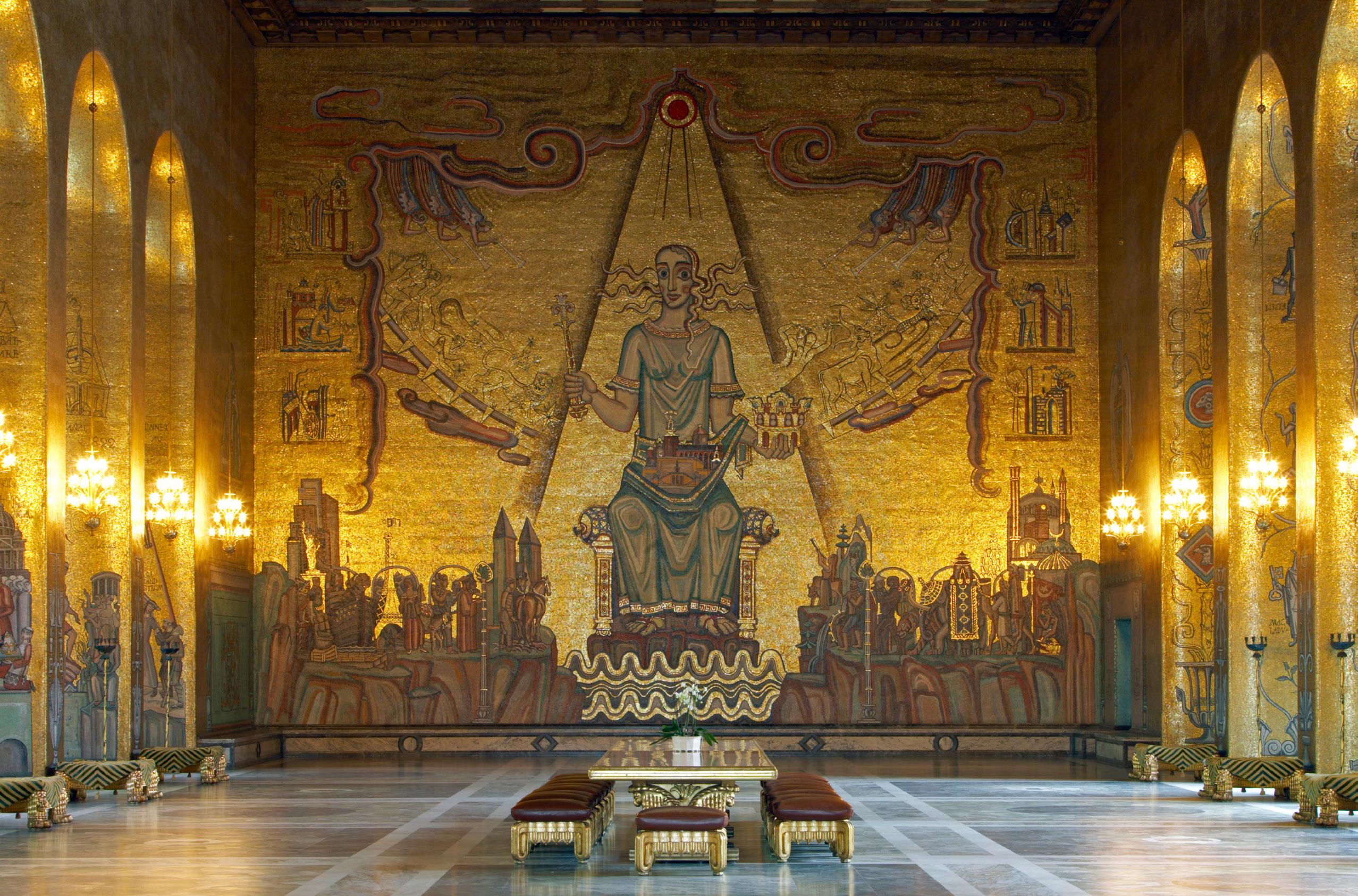

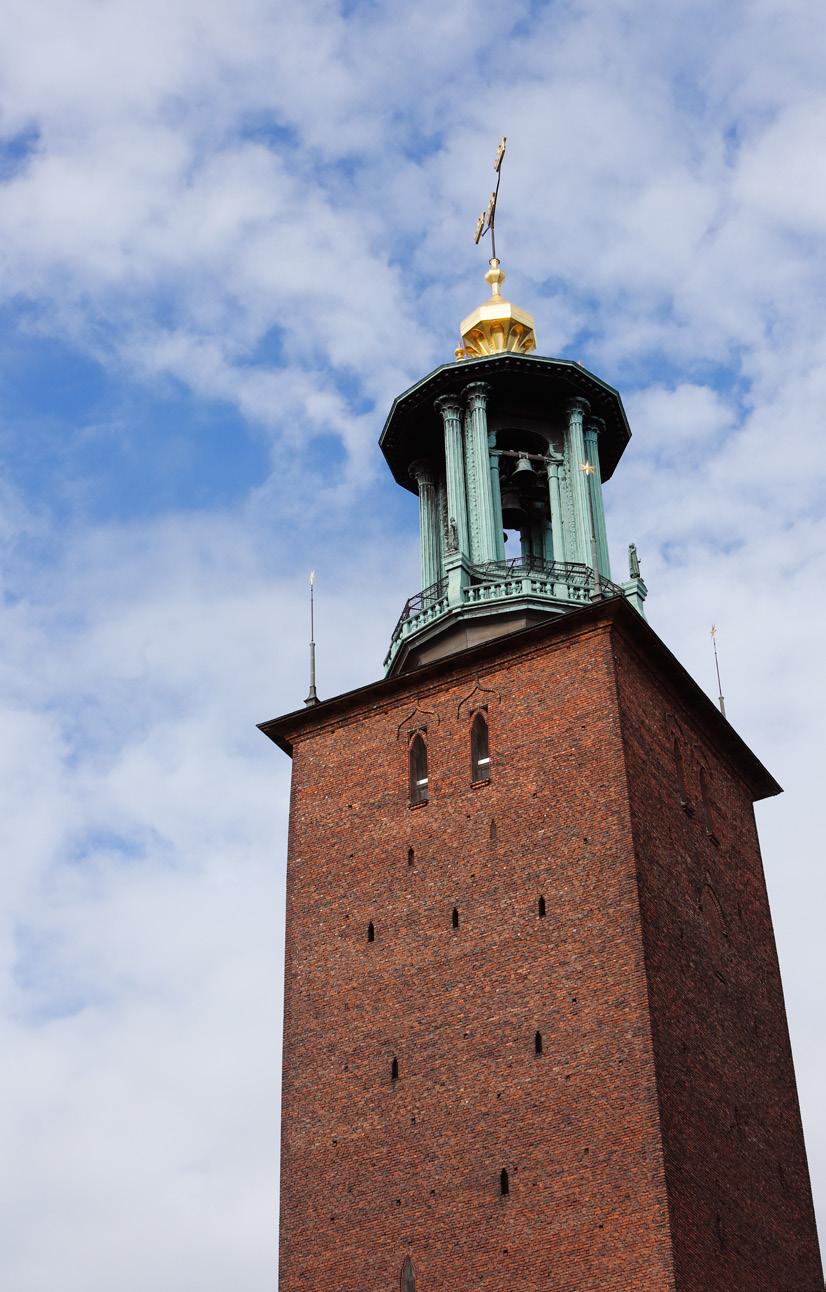
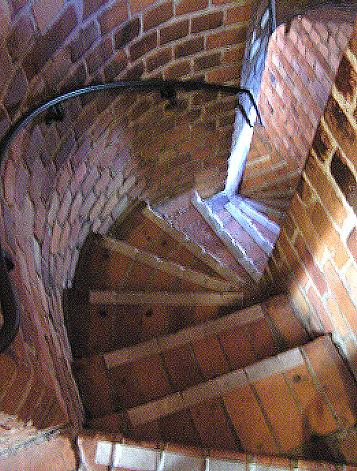
FEBRUARY 01, 2023 13
“Mälardrottningen” - The Queen of Lake Mälaren.
To reach the Tower lookout you have to climb the very steep 365 steps ... Municipal Assembly meeting hall.
Photo: Holger Ellgard
Searching for the real Jenny Lind
I’ve been a fan of Jenny Lind for a long time. Recently, I read a biography of the famous singer (The Life of Jenny Lind: Briefly Told by Her Daughter, Cassell and Company LTD), published by her daughter Jenny Maria Catherine Goldschmidt Maude in 1926. It was reissued in 1977 by Arno Press, reprinted from a copy in the Princeton University Library. Jenny Maude’s account is fascinating, in part because of the many details she provides of her mother’s complex life and career but also because of what she omits or doesn’t fully disclose.
Lind was a powerful cultural icon, a kind of creation that doesn’t allow for the acknowledgement of faults or blemishes. Her daughter’s biography reminds us that family members may have a stake in perpetuating idealized notions of their famous relatives. It is always wise to consider who is telling a story, and to remember that every story told is also biased. Throughout the biography, readers may sense cracks in the icon, based on allusions and avoidance of certain topics. Jenny Maude also doesn’t always examine Lind’s life in the context of her cultural and social environment, another way she shows her biases.
Jenny Lind’s daughter’s account is part of a series of opera biographies. Maude clearly did her due diligence here; she meticulously traces her mother’s performance history, documenting just about every one of Lind’s musical appearances in both Europe and the United States.
The first tip that we are not getting the full story, however, comes early in the book. Lind’s mother divorced her first husband for adultery but refused to remarry until after his death in 1834. She didn’t marry her second husband, Lind’s father, until 1834, when Lind was 14 years old. This meant that, by law, Lind’s birth was illegitimate. These various circumstances are not mentioned in the book.
Maude does tell us that her mother was born in 1820 in Klara, in central Stockholm, “to middle class parents, the mother being a well educated woman a good deal older than her father.” [1] Of him, Nicholas Jonas Lind, 22, we are told he was not a very responsible fellow, in what way is not specified. Given other omissions from the biography, one can’t help wondering.
Her mother already had a 9-year-old daughter when Jenny was born. Her mother was hardworking and busy, taking charge of the household affairs while also running a day-school for girls out of her home (and remember that her husband was not a very responsible fellow, suggesting he did not have regular work). She put Jenny out to nurse with the wife of a village church organist, presumably because she couldn’t spare time to look after an infant. Lind returned home at the age of four.
The June 15, 2022 issue of Nordstjernan ran an item that caught my eye: “A Swedish nightingale returns.” It featured the recipient of the Jenny Lind Scholarship, the soprano Tessan-Maria Lehmussaari, along with a stunning photo of her. The prize was awarded by the Royal Swedish Musical Society and Folkets Hus & Parker in 2020, the year of the 200th anniversary of the Jenny Lind celebration. A scheduled performance tour was delayed until this year, presumably because of the pandemic. Like her “namesake,” the new Jenny Lind went on tour in Sweden and then the United States, dazzling audiences with her musicianship.
According to the biography, Lind’s mother was never emotionally available to her young child. The grandmother, who lived with the family, provided the emotional support that her mother, with her “less genial nature,” seemed incapable of providing.
It is tempting, however, to put another spin on the mother’s remoteness. As the head of household, running a business and supporting an extended family, she was most likely frazzled and exhausted most of the time, and she sensibly placed her daughter in a situation where she could receive more attention.
Whether it was actually the mother’s less genial nature or her frenetic schedule, it was the grandmother who was a major influence on young Jenny, imbuing her with her own strong religious beliefs. It was also the grandmother who discovered Jenny playing a tune on an old spinet piano stored in the attic. Jenny soon began to sing everything she heard. At only 9 years old, her talents were noticed and she was admitted to the Royal Theatre School.
At first her family was less than enthusiastic about her pursuit of a stage career, and the biography does not explore the cultural and social factors behind their prejudice. Lind grew up in a Victorian world (her dates coincide neatly with Britain’s Queen Victoria), when standards of moral conduct were much more rigorous. In that era, women of the stage were often seen as loose, of uncertain morals. Also, female performers often did not marry; their demanding careers did not leave time for husbands, children, and housewifery. In short, these women did not fit the role of the conventional woman and were for that reason threatening to the moral order.
When Jenny Lind did finally marry toward the end of her career, she had children. (One viable marriage opportunity when she was younger fell through because her fiancé’s family, like her own, did not approve of the stage and its traditions. She felt she could not endure their narrow views and called off the engagement.)
Singular success at a young age
Her family had backed off from opposing a stage career when they realized what educational advantages their daughter would receive at the school where she was admitted. Her education resonates somewhat with the story of “My Fair Lady.” She was trained in elocution, languages, deportment and the regular school curriculum, as well as piano, dancing and singing. She learned to “move, walk, and hold herself with perfect poise and dignity. She became an accomplished pianist, and improvised easily, especially notable when she sang Swedish songs.”
School was stimulating and fun for her, but her home life was difficult: “the austerity of outlook affected her nature, and induced a seriousness which she never lost.” This observation by her author daughter again fails to recognize that Swedish society as a whole, not just Lind’s family, was bound by a certain moral strictness and propriety in the early 1800s. With an artist’s temperament from an early age, and exposure to more liberal views at school, it should be no surprise that Jenny Lind chafed against the strictures of the general culture.
By the age of 10 she appeared in her first play. By age 12, a local performance was noted in a newspaper, which praised her memory and technical feats at so young an age. By the time she was 17, Jenny was earning a salary and had performed over 100 times in 15 different plays as well as an opera.
Her career really took off in 1838, when she sang in Anton Webern’s opera Der Freischutz. This event initiated Lind’s whirlwind career; her many performances, often occurring back to back, are hard to keep track of. At one point, she put too much strain on her voice and had to take a break from performing. At 19, she also made a break from her family, deciding to move out and live on her own.
By 1840 she was singing the role of Donna Anna in Don Giovanni and Lucia in Lucia di Lammermoor. She was only 20, and these are demanding roles. It is about this time that a newspaper article
14 NORDSTJERNAN feature
called her “the Nightingale,” a name which followed her through life. In that year, she was also made a member of the Swedish Academy of Music.
By 1841 she had sung in the opera Norma 447 times at the Royal Theatre. She was fatigued, her voice tired and taxed, and she asked for a break. Friends arranged to send her to Paris, where she stayed in a boarding house with a maid. She knew practically no one there, but Queen Desidera of Sweden had given her an introduction to a relative, and she quickly made social connections.
An independent Victorian woman
Throughout the account of this whirlwind career the reader gets only occasional glimpses of the personal conflicts and emotional strain that Jenny Lind must have experienced throughout her life. It is not clear whether her daughter’s reticence or lack of documented details explains this gap.
Maude, moreover, doesn’t mention that her mother was ambitious, seeking new opportunities where she could throughout her career. The Swedish
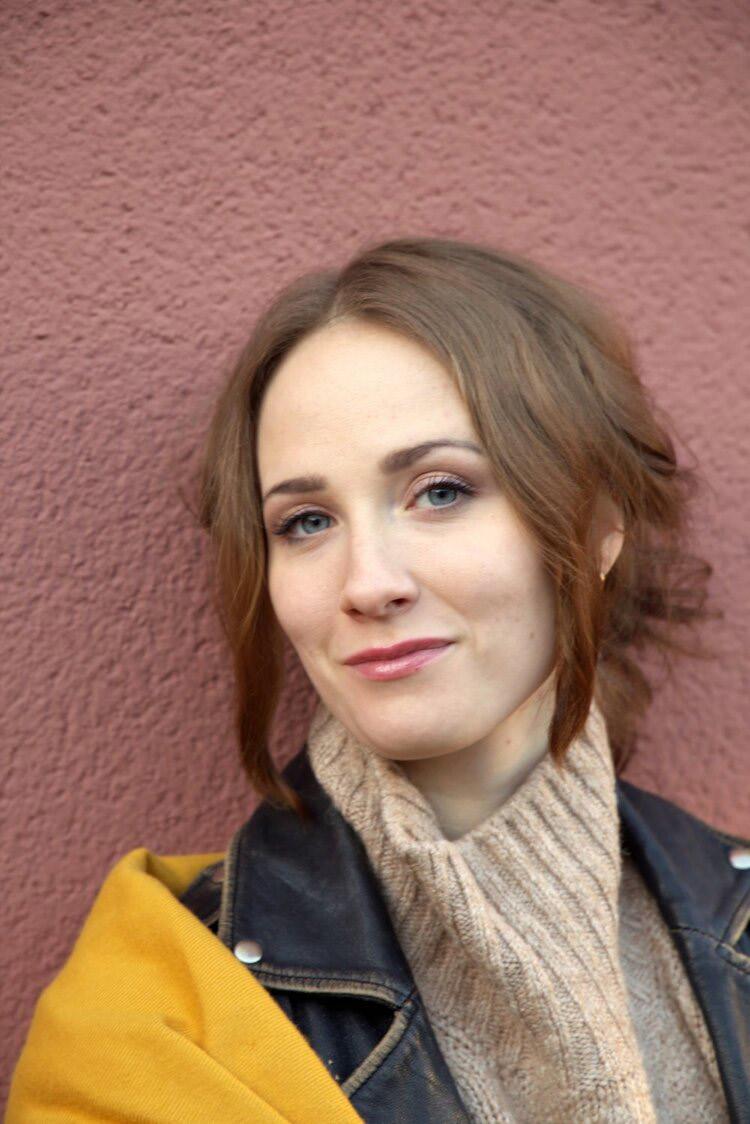
Nightingale was very conscious of her worth and got into more than one dispute over payment. The number of performances was often an issue, which is not a surprise. Jenny Lind exhibited a certain business acumen, negotiating deals and keeping control of her finances at key points in her career. When she finally did marry, she drew up her own marriage settlement (something almost unheard of at the time), reserving exclusive control over a portion of her fortune. She named her husband executor of the larger fund that was used for charities. Perhaps this observation is too speculative, but it is possible that she absorbed some business sense from her mother, who ran the day school.
Lind had a dizzying performance schedule in Europe before she went on tour in the United States. She was friends with and feted by royalty and well known composers like Robert Schumann wherever she went in Northern Europe. She sang as part of a concert with Clara Schumann in Vienna in 1847, who noted, “I am so fond of her. She is for me the warmest, noblest being that I have found among artists.”
At a party given by the princess of Prussia, the British Ambassador Lady Westmorland, described how, “on entering the concert room, she saw a pale faced girl badly dressed and looking like a shy schoolgirl sitting by the piano … everyone began speculating as to whether Meyerbeer had been playing a practical joke when raving about the new singer he had discovered. His answer to Lady Westmorland’s inquiry was merely, “Attendez, Miladi.” And sure enough, once Lind started singing, all doubts were swept away.
Another piece of insight into the icon is that Jenny Lind was plain-faced and had little fashion sense, and yet the many depictions of her convey a beautiful face with a swanlike neck, and a fetching, low-cut garment draped around her shoulders. Photographs reveal how little the actual woman resembled the portraits of her, but icons are constructed of idealization and replicated, recognizable features; and they often override our perceptions of the real thing. It is also true that when Lind began to sing, she appeared to be

FEBRUARY 01, 2023 15
“Jenny Lind (1820-1887) on engraving from 1859. Swedish opera singer. Engraved by N.Afinger and published in Meyers Konversations-Lexikon, Germany,1859.”
Photo: Mirella Lemussaari
The 2022 Jenny Lind Scholarship recipient, soprano Tessan-Maria Lehmussaari.
transfigured, a sort of ethereal beauty emanating from her, which captured her audiences.
She was a big success in Berlin, and England was getting interested in having her sing. In a weak moment, she signed a contract with a Mr. Bunn, an affiliate with the Drury Lane Theatre, to extend her European tour. She tried to cancel the contract but Bunn wouldn’t let her out of it. An illness followed, perhaps caused by stress, though no one knows. Again, if her daughter knew, she does not give us details. This incident precedes and almost predicts the problems she gets into with P.T. Barnum, the promoter who brought Lind to the U.S. in 1845.
Lind-mania in America
Barnum sent an agent to her in Sweden to entice her to come to America. Once he signed her up, he went all out in promoting the tour, and his advertising outreach is credited with fostering the Lind-mania that swept through both Europe and America. But Lind-mania was a phenomenon in Europe well before her tours in the U.S. Hans Christian Andersen acknowledged her in his story “Das Marchen meines Lebens,” and she was the subject of odes by many poets.
The London Punch published rhymed verses as well as articles in 1847-8, tracking her popularity in a satiric vein. Her daughter lists the many things named after her, including cigars, servants’ caps, melons, and flies for trout fishing. In the Alaska Gold Rush, a baker (most likely a Swede) advertised his Jenny Lind cakes on the door of his shanty. At times all this adulation tired and irritated Lind, but she expressed these feelings privately.

Her first concert in America was at Castle Garden in the fall of 1850. In New York City, she sang in a hall stuffed to the gills with 11,000 people. These statistics give a foretaste of the wealth and popularity she would accrue from this tour. But Lind did have her critics. Some thought her voice wasn’t right for opera; some found minor techni-
cal flaws, but, undeniably, she was able to project emotion that captured audiences’ full attention and admiration. Few who heard her sing could escape the spell she cast over the room.
Relationship with Mendelssohn
Lind’s daughter had access to letters and other private documents, and yet she does not fully address her mother’s relationship with the renowned composer Felix Mendelssohn. Recently, some documents have come to light, suggesting a romantic attraction, and possibly a sexual liaison between the two.
Lind’s friend Meyerbeer, who had already composed for her, arranged for a court appearance where she met Mendelssohn. He was smitten with her immediately.
In 1846, she sang under Mendelssohn’s baton at the Aachen festival, then spent several days on the Rhine with him and a group of friends. Perhaps this is speculating too much, but one may wonder what a married man is doing on a boat on the Rhine, out of public view, in the company of a woman whom he idolized.
Mendelssohn worked with Lind on many occasions and wrote several pieces with her voice in mind, most notably the soprano aria in his oratorio Elijah (“Hear Ye Israel”), which he was working on while performing his conducting duties at Aachen.
Whatever their involvement might have been, he and Lind obviously bonded as musical professionals. They recognized each other as top artistic talents in their respective fields of expertise. They also had a mutual drive for perfection and understood the wearying impacts of performance deadlines. The two tended to overtax themselves with work, and their letters convey their need for respites now and again.
Lind’s daughter’s biography includes several personal letters from Mendelssohn. They bear the marks of friendship, at one point thanking her for the Swedish bread she sent his family. But even when he refers to her as a friend, there is a tone that suggests some greater intimacy and infatuation. In a letter written soon after they meet, he begs her to never change and to accept gifts from him, enclosing an album of songs and a couple watercolor drawings. He also wanted her to come to England when he was living there so he could work with her, but also see more of her. When friends urge her to return there, he adds, “I for my part would be very glad indeed if you were to go….”
It would appear his entreaties were, in fact, a big draw: She returned, and in London, her close relationship with Mendelssohn continued.
Felix Mendelssohn (1809-1847) was only 38 when he died. The cause of his death was most likely an aneurysm. It has been suggested, however, that he died by suicide, or of grief, because Lind had rebuffed his amorous overtures. In 2013, George Biddlecombe, in the Journal of the Royal Musical Association, confirmed that “The Committee of the Mendelssohn Scholarship Foundation possesses material indicating that Mendelssohn
wrote passionate love letters to Lind entreating her to join him in an adulterous relationship and threatening suicide as a means of exerting pressure upon her, and that these letters were destroyed on being discovered after her death.” If Jenny Maude had access to these letters, she made the conscious choice to avoid the whole topic in her book.
We do know that Lind was deeply grieved by Mendelssohn’s premature death. Four months after her London debut, she was not able to sing the soprano part in Elijah, which he had written for her. She was finally able to do it at a performance in London’s Exeter Hall in late 1848, which raised £1,000 to fund a musical scholarship in his name. The first recipient of the Mendelssohn Scholarship was the 14-year-old Arthur Sullivan, whom Lind encouraged in his career.
Her marriage
Lind married Otto Goldschmidt in Boston before she ended her tour of the U.S. in 1852. They had been friends for some time, and he had followed her to the U.S., taking over some of the management of her tour.
Again, what is left out is often as revealing as what is said. Maude does not mention that both Mendelssohn and Goldschmidt were Jewish. Mendelssohn’s family was highly educated and prominent in the Jewish community. His immediate family had converted to Christianity, but Mendelssohn was always mindful of his Jewish roots. His oratorio Elijah celebrates a prophet from the Old Testament.
Of Goldschmidt we are told only that he “came of a good Hamburg merchant family.” The daughter’s biography does not mention that like Mendelssohn his wealthy and well educated parents belonged to the community of German liberal Reform Jews. Both came from families that put a high value on a musical education. And both men became composers and conductors (Goldschmidt at one point studied under Mendelssohn). Lind was most likely attracted to the two men because of their cultural sophistication, liberal attitudes and education.
Lind’s refusal to succumb to religious and cultural differences strikes us today as a plus, as we recognize the time when religious prejudice was much in evidence. Jews had only been permitted to live in Sweden since the late 18th century, with minor exceptions for converts to Lutheranism. As late as 1854, certain Swedish towns did not even allow Jews to reside or own property in the countryside. It was not until 1870 that Jews received full citizen rights and membership in the Riksdag. Antisemitic attitudes lingered among the population, then as now.
Lind remained Lutheran her whole life and was a regular church goer. To please her, Goldschmidt became an Episcopalian (why not Lutheran isn’t clear). Like Mendelssohn’s family’s conversion to Christianity and the Lutheran Church, this move was one way to better assimilate into the general culture, a widespread phenomenon at the time.
Married and back in Sweden, Goldschmidt was
16 NORDSTJERNAN feature
accused of squandering Lind’s money, and the couple took a case to court to quiet the libelers. (One can’t help wondering if antisemitism was involved.) He appeared to have been a loving and attentive husband, so the accusations must have been particularly galling to Lind. His reputation salvaged, he was later accepted into the VASA order.
The long view
Between the lines of Jenny Maude’s account, I sense a woman who rose above the cultural narrowness of her day, open to new experience and accepting cultural and social differences. We know she had a generous side, contributing to numerous charities, always mindful of the less fortunate among us. On a personal level, in the two most important relationships of her adult life, she exhibited an open mind and heart, untouched by cultural prejudices which still manage to plague us.
She wasn’t perfect, but who is? Foibles and irritations can help us see an iconic personality as more human and vulnerable. At the height of her career, Lind confessed privately to becoming annoyed by all the widespread adoration, an attitude which she could not afford to show in public. In her later years there was “a sense of aloofness and almost haughtiness with those who were not her friends, this attitude giving offense to intruders on her private life whose visits she resented, and Mr. Goldschmidt had to use all his powers of diplomacy to put things right again.”
Today, when movie stars walk down the street, they are often the objects of unwanted attention. Not a few have expressed a need for greater privacy and have sought seclusion from prying eyes. Early on Lind created a stage persona that she projected consistently. It is not difficult to understand that, beset constantly by public attention, she also craved privacy and something more akin to a normal domestic life, though she always maintained composure and exuded sweetness and charm in her public appearances.
Jenny Lind’s legacy
In 1863, the trustees of her account “instituted the Traveling Scholarships that today bear Jenny Lind’s name.” She also founded a Geijer Scholarship at Upsala and another bearing Bishop Tegner’s name at Lund University.

In a previous Nordstjernan article, I discussed her funding of the Jenny Lind Chapel in Illinois, today a public museum. Jenny Lind Hall in Oakland, California, still bears her name, as do various towns throughout the U.S. Today these markers are all mere traces of a once famous performer; many Americans do not know who she was, they might not even realize the 2017 movie “The Greatest Showman” was portraying a real person … as does its predecessor, Mark Bramble’s book and 1980 musical, “Barnum.”
Icons come and go, swept away by the next craze or fad. All the more reason to admire Sweden for keeping her name and legacy alive through
the singing scholarship awarded by the Swedish Royal Academy of Music and the People’s Parks and Community Centers in Stockholm, through which winners tour across Sweden and the U.S. Lind continued to perform for special occasions toward the end of her life, and according to her daughter, kept herself in good voice. She died at the age of 67. On the morning of the day she died,
she is said to have sung a few bars of Schumann’s “Sonnenshein” to welcome the sun. This statement of record again bears the mark of iconic construction. What a perfect way to imagine Jenny Lind, the Swedish Nightingale: She goes out singing. It is hard to imagine her voice while that ill, but I, for one, will buy it.
By Kitty Hughes
Above images are from the Andover, Ill. Jenny Lind Chapel we covered in our issue 1, 2023. The singer has been commemorated in music, on screen and even on banknotes. Many places and objects have been named for Lind, including Jenny Lind Island in Canada, the Jenny Lind locomotive and a clipper ship, the USS Nightingale. An Australian schooner was named Jenny Lind in her honor. In 1857, it was wrecked in a creek on the Queensland coast; the creek was accordingly named Jenny Lind Creek. A bronze statue of a seated Jenny Lind by Erik Rafael-Rådberg, dedicated in 1924, sits in the Framnäs section of Djurgården island in Stockholm. Lind is commemorated in Poets’ Corner, Westminster Abbey, London under the name “Jenny Lind-Goldschmidt”. There is also a plaque commemorating Lind in The Boltons, Kensington, London and a blue plaque at 189 Old Brompton Road, London, SW7.
In the US, Lind is commemorated by street names in Amelia, Ohio; Fort Smith, Arkansas; New Bedford, Massachusetts; Taunton, Massachusetts; McKeesport, Pennsylvania; North Easton, Massachusetts; North Highlands, California and Stanhope, New Jersey; and in the name of Jenny Lind, Arkansas. The town of Jenny Lind, California is likely named after her, although there are several tales about its naming. An elementary school in Minneapolis, Minnesota, and the Jenny Lind Tower, a stone tower in North Truro, Massachusetts, are named for her. She visited Mammoth Cave in central Kentucky in 1851, and a feature in the cave was named in her honor, called “Jenny Lind’s Armchair”.[Cottage-style spindled furniture is still named for her, especially Jenny Lind cribs and beds. The Jenny Lind Wing is part of a student residence building at Augustana College, Rock Island, Illinois. The college also named a Jenny Lind Vocal Ensemble. Jenny Lind soup is a soup named for her. And the American Swedish Historical Museum’s (see also page 22) Jenny Lind Room is devoted to her and the lasting effects of her widespread popularity in America.
As for Jenny Lind, the cake, turn to page 22 >>

FEBRUARY 01, 2023 17
A Visit to Sweden’s north

18 NORDSTJERNAN language & culture
Discover Swedish is not a regular language course. Teachers and other professionals in the language field may object to the fact that it leaves out bits and pieces, and simplifies language learning. That is a calculated move: These lessons are for regular readers, maybe even beginners, trying to get a grip on another language. Subscribers eager to look back at earlier lessons, numbers 1-54, please check our online digital content beginning with issue 16, 2019: www. nordstjernan.com/digital_issues
Apart from grammar and the overall structure of Swedish, these lessons also teach how to use your own experience with vocabulary. Discover Swedish
Korsord / Crossword puzzle
demonstrates shortcuts, mainly based on the influences of Latin and Greek—languages that are the foundation of English, Swedish and the Germanic languages. The lessons include crosswords, fill-in sections, personal questions, Odd Man Out, word groups, jokes, silly translations, short texts, all in a kind of Swedish atmosphere. By partaking in Discover Swedish you will no doubt get a grip on Swedish and you may even learn about svenska (the language) och svenskarna (the people of Sweden).
Christer Amnéus
A Visit to Northern Sweden
Inlandsbanan går från Mora (Dalarna) till Gällivare (Lappland). Den passerar Mora, Orsa, Sveg, Östersund, Sorsele och Jokkmokk. Banan är 1288 km (805 miles) lång och du ser många granar på väg mot norr. Lappland, del av Norrbottens län, med samer och deras renar, gränsar mot Norge i väster och Bottenviken i öster (den nordliga delen av Östersjön). Vid kusten finns städer som Luleå (med SSAB, stålindustri), Umeå (med universitet) och Piteå med sin palt (potatis, mjöl och fläsk). I Norrbottens inland finns Boden, ett militärt centrum. Där ligger också Kiruna, staden med sin gruva. Staden håller på att flyttas österut eftersom gruvan behöver större plats. En järnväg går från Kiruna till Narvik, Norge. Den byggdes av rallare. Mitt i Lappland ligger Esrange, en svensk Cape Canaveral. Längs gränsen till Finland talar många människor meänkiele, ett språk som liknar finskan, medan samerna har sina språk i resten av länet. Delar av Norrland är glesbygd med långt mellan byarna. Hede i Jämtland och Järvsö i Hälsingland är två exempel. Att äta surströmming är en tradition i många orter längs med Bottenviken. Åk dit!

Ordförråd/Vocabulary
Inlandsbanan: railway line del av: part of
roa: amuse den: it
går från: (here) runs from en gran, två granar: spruce, fir på väg mot: on your way to
norr: the North
glas: glass
toa, toalett: bathroom
samer: the Sami people en ren, två renar: reindeer
gränsa mot: border on

väster: west
öster: east
rim: rhyme
fe: fairy
Östersjön: the Baltic
vid kusten: along the coast en stad, två städer: town/city
make: husband (also: married man)
stålindustri: steelworks
bom: boom, loud sound
tom: empty
mjöl: flour
fläsk: pork
mua: the sound a cow makes gruva: mine
håller på att flyttas: is being moved (Yes, a complete town. No joke!)
aln: (59.38 cm), (out of date today) uv: (great horned) owl
Ume and Lule rivers
eftersom: as behöva: need större plats: more space
järnväg: railroad
byggdes av: built by navvy: rallare
längs gränsen: along the border
tala: speak
leva: live
språk: language
liknar finskan: sounds like Finnish medan: whereas
ö: island
å: creek
län: province (landskap is another word)
en del, två delar: part(s)
be: pray
ha: have
déjà vu: have gone thru that situation before glesbygd: less populated area
långt mellan byarna: long distance between villages/small towns
surströmming: fermented fish kept in barrels
yla: howl (wolf)
is: ice
en ort, två orter: small place(s)
Åk dit: Go there
Välkommen till nästa övning / Welcome to the next exercise: A summary of the content so far of Discover Swedish.
FEBRUARY 01, 2023 19 language & culture
Lesson 55
Key /p20
Drawing: Guillaume de Basly/imagebank.sweden
Key to crossword puzzle and longer text translated:

A Visit to Northern Sweden
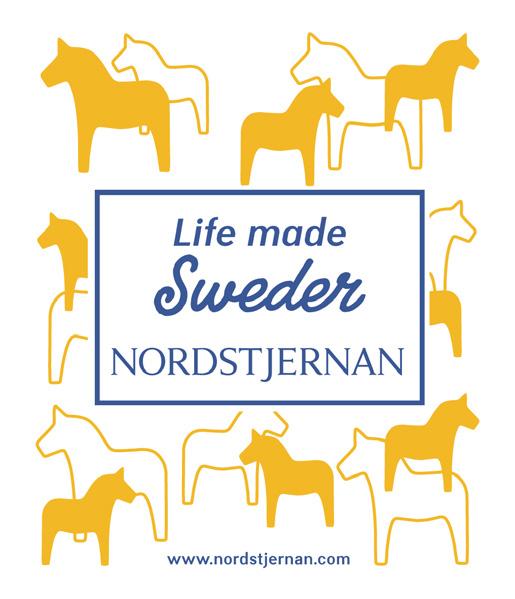
Inlandsbanan, the inland railway runs from Mora (Dalarna) to Gällivare (Lapland). It passes Mora, Orsa, Sveg, Östersund, Sorsele and Jokkmokk. The track is 1288 km (805 miles) long and you see a lot of fir trees heading north. Lapland, part of Norrbotten county, with Sami people and their reindeer, borders Norway in the west and the Gulf of Bothnia in the east (the northern part of the Baltic Sea). On the coast there are cities such as Luleå (with SSAB, steel industry), Umeå (with university) and Piteå with its palt (potatoes, flour and pork). In Norrbotten’s hinterland is Boden, a military center. There is also Kiruna, the town with its mine. The town is being moved east because the mine needs more space. A railway runs from Kiruna to Narvik, Norway. It was built by navvy. In the middle of Lapland lies Esrange, a Swedish Cape Canaveral. Along the border with Finland, many people speak Meänkiele, a language similar to Finnish, while the Sami have their own languages in the rest of the county. Parts of Norrland are sparsely populated with long distances between villages. Hede in Jämtland and Järvsö in Hälsingland are two examples. Eating surtrömming (fermented herring) is a tradition in many places along the Gulf of Bothnia. Go there!
Sweden’s official EU playlist
Between January 1 and June 30, Sweden chairs the EU’s Council of Ministers. In connection with the assignment, an official playlist titled “Songs from Sweden” has been released on the music platform Spotify. The list contains a number of different songs by Swedish artists such as ABBA, Robyn and Cornelis Vreeswijk, but also international productions where Swedes have been involved, for example Justin Timberlake’s hit “Can’t stop the feeling,” written and produced by Swedish born Max Martin. The list begins with ABBA’s “Dancing queen” and Robyn’s “Dancing on my own.” Yung Lean, Monica Zetterlund and Avicii are also among the selected artists. According to EU Minister Jessika Roswall, the purpose of the list is to give an image of Sweden as a country, but also to show its musical breadth. The songs on the list were voted for internally by the government office’s employees, with inspiration from the Swedish Institute’s Spotify list “National day of Sweden.”
the supreme swedish dish cloth
A Swedish invention, will make life much Sweeder in the kitchen - guaranteed! Eco friendly and durable 6 3/4” x 8”, machine washable (use it over and over again)

/ Price: $5.95 — order five now: $25.00

20 NORDSTJERNAN local events
Please send me ____ Dala Horse dish cloth(s) x $5.95 = ______ Please send me ____ Looks like lutefisk dish cloth(s) x $5.95 = ______ Please send me ____ Tomten dish cloth(s) x $5.95 = ______ Total: ______ m Total of 5 dish cloths at $25 ______
__________________________________________________________
________________________________________________________ City State Zip ___________________________________________________ Tel.______________________________________
Check enclosed payable to Nordstjernan m Please charge my credit card: Card# _________________________________ Exp. Date: _______ / _______ Signature _____________________________________ SSC Code:_________ Mail to: Nordstjernan, P.O. Box 680, Minneola FL 34755 Designed by NORDSTJERNAN, USA (Shipping included to continental U.S.)
Name
Address
m
Swedish News
Huge increase in food prices
The total price increase for food in 2022 was 18.6%, according to Statistics Sweden. Butter, sandwich margarine, household margarine and what SCB categorizes as “other sandwich fat” increased between 34 and 41 percent. Fish has become much more expensive with increases of around 30 percent. Fruit and vegetables have also increased in price, as have potatoes, flour, pasta and rice. White cabbage is the commodity that has increased the most in the past year - with an increase of 66.3 percent. The price of cauliflower, on the other hand, decreased 4.2 percent. The inflation rate rose again in December, according to Statistics Sweden and was on an annual basis at 10.2 percent, partly caused by sharply increasing electricity prices: +28% during December.
Increased support for nuclear
Swedes have become significantly more positive about nuclear power and only one in 10 currently wants to phase out this energy source, according to an opinion poll from the so-called Analysgruppen, which assigned Novus to survey around a thousand Swedes. Almost six in 10 responded that they can imagine “continuing to use nuclear power and, if necessary, build new reactors.” At the end of 2017, that figure was just under 30 percent and a year ago around 45 percent. The biggest change is among women.
New entrepreneurship affected
The economic situation in 2022 affected Swedish start-ups. The number of newly started companies fell six percent compared to the year before, according to statistics from the Swedish Companies Registration Office. A total of 71,140 companies were started and the worst development was on Gotland, where the number of new companies decreased by 18 percent. The only county showing positive figures is Norrbotten in the north with an increase of 12 percent.
Bankruptcies despite support
The Swedish Tax Agency has started bankrupting companies for not being able to make installment payments on taxes they were given a deferral for during the pandemic. Since December 2022, 150 companies have been declared bankrupt after failing to make payments. It concerns a total of 24,000 companies that received tax deferrals to an amount of SEK 34 billion.
Used furniture benefits climate
Buying used instead of new furniture can reduce the climate impact by 92 percent, according to a report from the Nature Conservation Association. The climate effect of buying one new armchair is as great as for 24 used ones, additional transportation costs withstanding.
Viking Age migrations can be seen in Swedes’ DNA
Many Swedes still carry genes from the wave of people from England and Ireland who moved to Sweden during the Viking Age. Immigrants from the east at the time, on the other hand, do not seem to have had as many children, a new study shows. People often speak of the Vikings as a traveling people, with contacts far out in the world. Now a new Swedish-Icelandic study of ancient DNA shows that the period between the year 750 and 1050 also meant a peak in immigration of people to Denmark, Norway and Sweden.
The study, based on 297 ancient Scandinavian genomes analyzed together with the genomic data of 16,638 present day Scandinavians, resolves the complex relations between geography, ancestry, and gene flow in Scandinavia – encompassing the Roman Age, the Viking Age and later periods. A surprising increase of variation during the Viking period indicates that gene flow into Scandinavia was especially intense during this period.
Another new discovery in this study was what happened to the gene pool after the Viking period. The scientists were surprised to find that it bounced back in the direction of what it looked like before the Viking period migration. Professor Anders Götherström at the Centre for Palaeogenetics, who is a senior scientist on the study, is intrigued: “Interest-

The study, led by Dr. Ricardo Rodríguez Varela and Professor Anders Götherström at Stockholm University, and Professor Agnar Helgason and Kristjáan Moore at deCODE in Reykavijk, has gained a lot of international publicity.

ingly, the non-local ancestry peaks during the Viking period while being lower before and after. The drop in current levels of external ancestry suggests that the Viking-period migrants got less children, or somehow contributed proportionally less to the gene pool than the people who were already in Scandinavia.”
A new discovery was the history of the northern Scandinavian gene pool. There is a genetic component in northern Scandinavia that is rare in central and western Europe, and the scientists were able to track this component in northern Scandinavia through the latest 1000 years.
The study is based on a number of well-known Swedish archaeological sites. For example, there are genomes from the 17th century warship Kronan, from the Viking and Vendel period boat burials in the lake Mälaren Valley, and from the migration period ring fortress Sandby borg on Öland.
Anders Götherström concludes: “We were working on a number of smaller studies on different archaeological sites. And at some point it just made sense to combine them into a larger study on the development of the Scandinavian gene pool.”
The study, published in Cell, is an international effort with several collaborators led by Dr. Ricardo Rodríguez Varela and Professor Anders Götherström at Stockholm University, and Professor Agnar Helgason and Kristjáan Moore at deCODE in Reykavijk.
The Centre for Palaeogenetics (CPG) is a joint venture between Stockholm University and the Swedish Museum of Natural History - www.palaeogenetics.com. The article “The genetic history of Scandinavia from the Roman Iron Age to the present” was published in the journal Cell, which publishes findings of unusual significance in any area of experimental biology.
FEBRUARY 01, 2023 21
Jenny Lind, the Cake
These cakes were evidently originally named after the famous singer Jenny Lind. Who knows why ... was it a favorite of the Swedish singer? Originally her recipe? Or just a marketing pitch? Be that as it may, whatever is the real story behind the cake, we do know Americans flocked to her concerts as Lind sang all over the country during her 1850s U.S. tour. Even those who could not attend, participated in the Lind-mania by purchasing all manner of items bearing the singer’s name—bonnets, shawls, jewelry, even cigars and pastries. None of the items were licensed, her name was never trademarked or regulated, but in this way virtually every American participated in the glamour and fame of the Swedish nightingale.
We found a few different recipes for the cake—all of them a bit bland but also inviting the use of other natural flavors such as lemon, vanilla, coconut with a splash of rum or berries and served with a helping of whipped cream or ice cream.
Recipe for a Jenny Lind cake

Ingredients
1 cup sugar
1/2 cup butter
3 eggs
1/2 cup milk
2 cups flour
1/2 teaspoon salt
2 teaspoons baking powder
2 teaspoons vanilla
Directions
Cream together butter, eggs, milk and sugar. Sift dry ingredients and add to butter mixture. Bake at 350° for 35 minutes.
And for the Jenny Lind cakes
This from the Emily [Bradenbaugh] Niernsee’s cookbook of 1861 and was included in a historical blog post from Maryland, www.oldlineplate.com
Stir a coffee cup of butter with one pound of pulverized sugar – add the yolks of 6 eggs well beaten – 1 teaspoon of soda dissolved in a cup of milk, 2 teaspoons of cream tartar in four(4) cups flour. Beat the whites very light and add alternately with the flour. Flavor with lemon or vanilla.
Both recipes really tell only the bare minimum but if you look above, the aforementioned blog writer must have succeeded with at least a visually delicious cake. /Ed.
DID YOU KNOW?
The construction cost of Stockholm City Hall between 1911 and 1923 amounted to SEK 18,206,206 (approximately $2 million), of which 1,726,206 were donations (all in 1924 monetary value). Without major donations, Stockholm City Hall could not have been completed. This also applies to the roofs. Three roof sections (south, east and north) are covered with copper plates, the other roofs are covered with tile. In order to enable the increase in quality, a fundraiser began in April 1920, where over 3,000 donors donated copper plates. The three roof sections are depicted in the so-called Copper Book where each of the copper plates are numbered and its donor named. The plates were estimated to cost SEK 25 and weighed 14 pounds each. The collection yielded nearly SEK 87,000, which also covered two monumental flagpoles. The Copper Book, designed by Ernst Hawerman is stored at City Hall.

The building’s architect Ragnar Östberg is estimated to have earned around SEK 200,000 (equivalent to just over 7.5 million in today’s monetary value) during the 20 years of the project and construction. The pay was also meant to cover his staff, however. In 1924, as a thank-you for his work, he was granted an annual annuity of SEK 7,000.
Entrance to the American Swedish Historical Museum in Philadelphia’s FDR Park. The architect of the museum, Swedish-American John Nydén, combined architectural features from three prominent edifices in his design. He modeled the main building after a seventeenth-century Swedish manor house, Eriksberg in Södermanland. The copper cupola atop the building is inspired by the one on Stockhlom’s City Hall The arcades flanking the Museum were patterned after those at George Washington’s home, Mount Vernon while the main building was modeled after a seventeenth-century Swedish manor house, Eriksberg in Södermanland and the copper cupola atop the building is inspired by the one on Stockhlom’s City Hall. The museum was founded just after the inauguration of the Stockholm building, in 1926. For more info, see www.americanswedish.org

22 NORDSTJERNAN feature
Jenny Lind cakes. Recipe from Emily Niernsee’s cookbook of 1861. Photo: www.oldlineplate.com
They think I look funny? (Midsummer is really all about perspective.)
[The] Swede is a blueprint for being Swedish: Not too little and not too much, simply lagom. Over 250 brief chapters, usefully organized like a dictionary, will make you a better Swede or at least better understand your Swedish friends, family or colleagues.


[The] Swede was written with the intent of introducing Sweden and Swedes to English speakers. It’s personal and informal and inspired by the author’s perspective of a country he loves dearly. Smörgåsbord, ombudsman and of course fika are words that were eventually adopted into English; and [The] Swede will introduce you to the rest—from allemansrätt to housewives, hugging, humor and husesyn—what does it mean to be un-Swedish? What about Swedish sin, is it a real thing? Are Swedes boring? Are they serious? Does a person bring bananas to a dinner party?

The family operated Dalahäst Roasting Co. is a craft coffee roastery in Jamestown, NY based in Peterson Farm. We roast in small batches for a consistent product and keep Scandinavian traditions alive through our love of a great full-bodied cup of coffee. Whole bean and ground. We ship anywhere in the U.S. All coffee Fair Trade Certified.


Card #
Exp. Date: / SCC Code: Signature


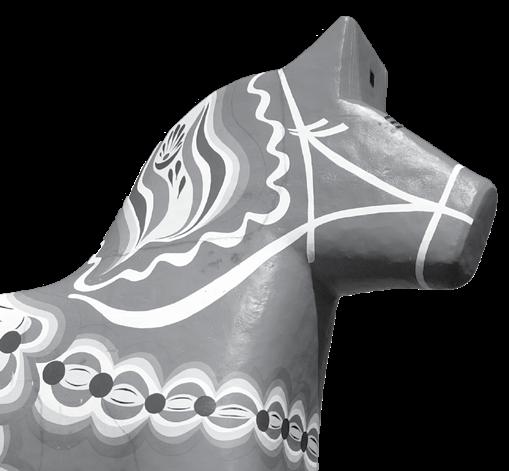

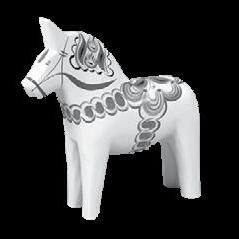

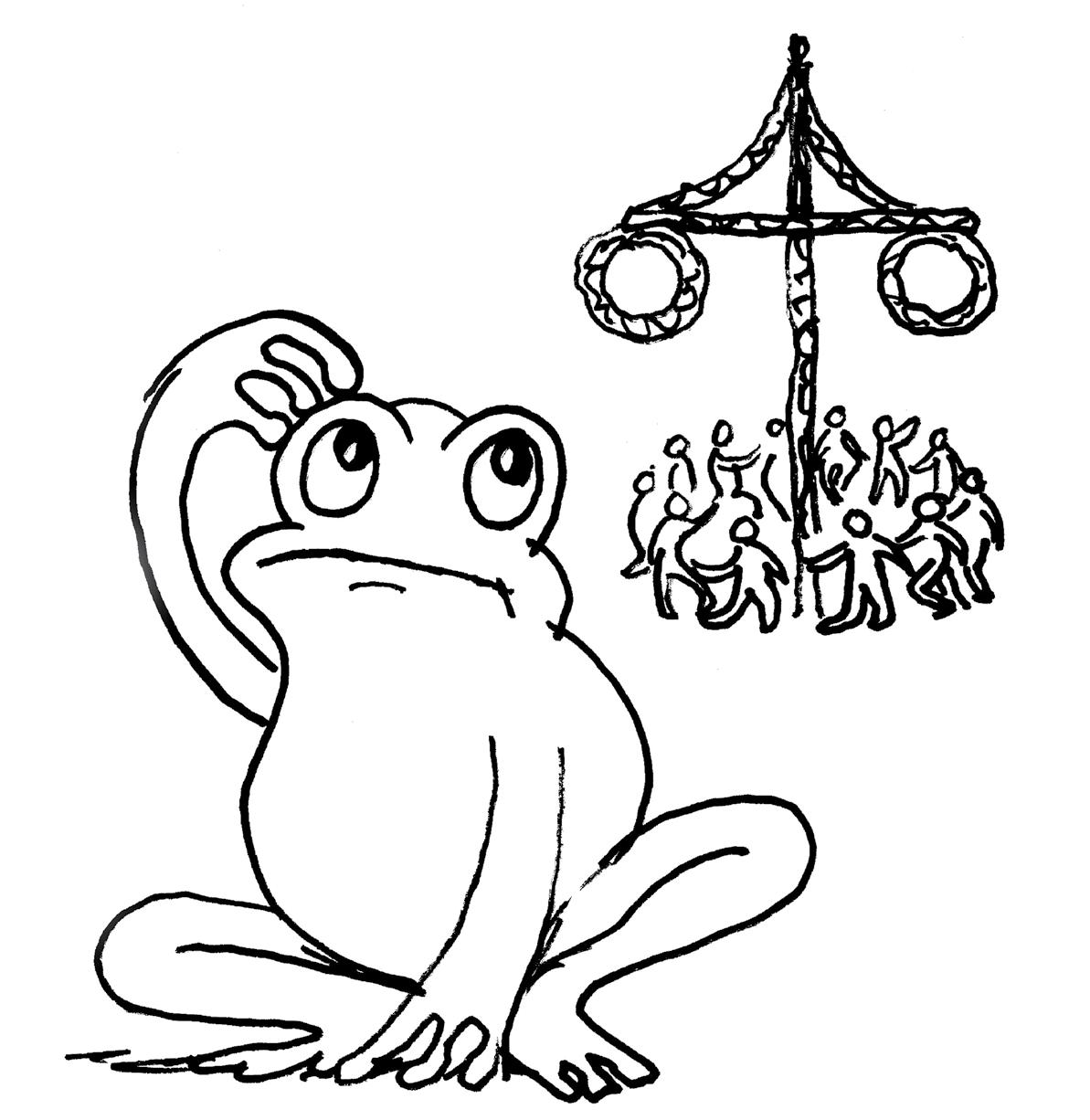
FEBRUARY 01, 2023 23 local events
paperback, the ideal companion for anyone to prepare for a touch of Swedishness
Perfect bound,
send me book(s) x $22.90 = Shipping included for subscribers (in the continental U.S.)
Mail order form to: NORDSTJERNAN P.O. Box 680 Minneola FL 34755 Or call 1.800.827.9333 Please
Total: Name Address City, State, Zip Tel.
Check enclosed payable to Nordstjernan Please charge my credit card:
Written by Christer Amnéus. Illustrated by Bo Zaunders.
place
S v e n s k B u t i k S w e d i s h G i f t s 1465 Draper Street Kingsburg, California 93631 (559) 897-5119 Facebook: Svensk Butik Swedish Gifts swedensfinest.com Toll Free: (888) 867-9567 A SWEDISH AFFAIR
Horses and much more! LEGAL SERVICES, VISA, IMMIGRATION, WORK PERMITS, INTERNATIONAL PROBATE (BOUPPTECKNING), WILLS, INHERITANCE, ESTATE Contact: The Law Offices of Jan G. Johansson Tel. 212-517-2750 Email: JJlaw@msn.com 360 E 72nd Street, Suite A1500 New York, New York 10021 FOR ALL YOUR LEGAL NEEDS 30 Years of providing legal service to the AmericanScandinavian Community VI TALAR SVENSKA
SwedishCookbookFamily One family’s story of emigration, a look at Swedish traditions and a smörgåsbord of 80+ delicious recipes. Available at local bookstores, Amazon and on BN.com Scandinavian Traditions Downtown Lindsborg, KS Call for free catalog! Gifts Crafts & More! 800.779.3344 www.hemslojd.com Importer of Swedish Workwear Björnkläder Innovative workwear for professionals info@facelineinc.com phone: 510 215 2211 toll free: 877 234 9511 www.facelineinc.com To order, see www.petersonfarmswede.com or call 716.483.2202
coffee
people.
market
Nestled in the heart of the Swedish Village of Kingsburg...
Dala
A
Great
makes better
Two years in a nutshell


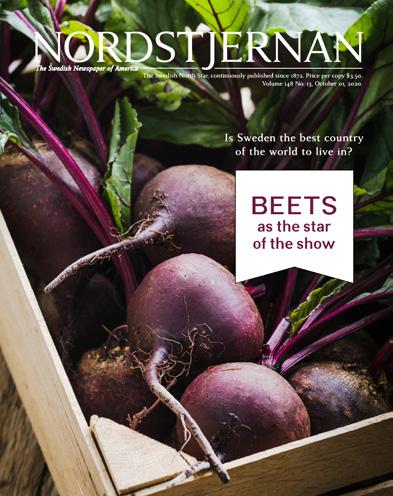

celebrating 151 years in 2023
